How to Freeze and Thaw Cakes
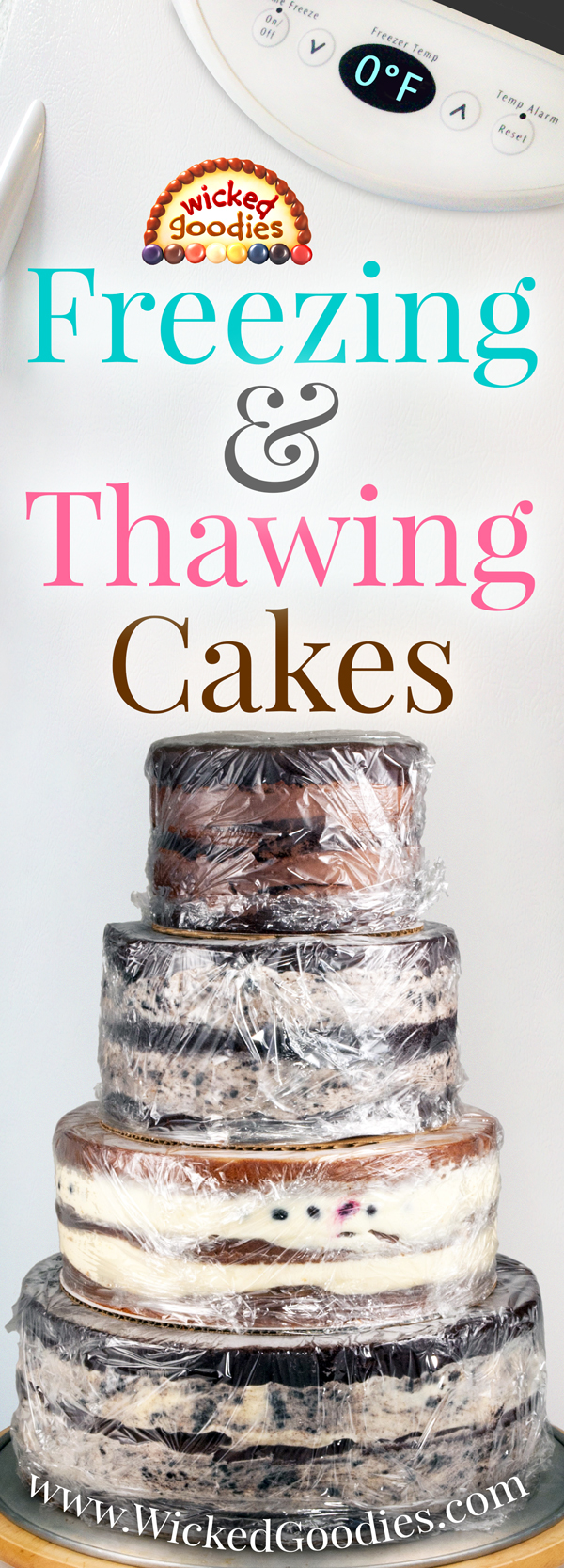 This video covers the topic of freezing cake at all stages including baked cakes, sliced cake layers, filled cakes, frosted cakes and decorated cakes. It covers the pros and cons of freezing cakes plus offers solutions to common problems that may occur as a result of freezing. It approaches the matter the way many bakeries do, by building layer cakes in the baking pan. If you are new to this method, start here: How to Fill Layer Cakes in the Pan. If you just need a refresher, watch the video series below.
This video covers the topic of freezing cake at all stages including baked cakes, sliced cake layers, filled cakes, frosted cakes and decorated cakes. It covers the pros and cons of freezing cakes plus offers solutions to common problems that may occur as a result of freezing. It approaches the matter the way many bakeries do, by building layer cakes in the baking pan. If you are new to this method, start here: How to Fill Layer Cakes in the Pan. If you just need a refresher, watch the video series below.
VIDEO: Cake Filling Method – Freezing Cakes
It’s a myth that freezing cakes is bad.
In fact the opposite is true.

The Truth About Freezing Cakes
The truth is that a lot of bakeries freeze their products, including the cakes. It’s easiest, safest way to maintain an inventory of perishable products. Too many days in the refrigerator causes cakes to go stale so we only thaw what we intend to sell in the next 48 hours. The rest, we store in the freezer. The same goes for bread. The truth is that a disappointingly stale cake or loaf of bread you bought from a bakery is probably just an aging product that was not frozen when it should have been.
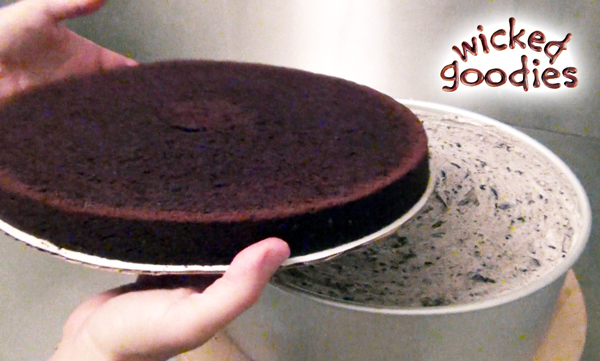
The Best Way to Freeze a Cake is in the Pan
The best way to freeze a cake is to do so after assembling the filling layers and before frosting and decorating it. I would argue this is the best way to build the insides of a cake. Yes, I intentionally freeze my cakes every time using a trick that involves stacking the layers within the baking pan using this cake filling method. The pan serves as a handy mold. It also protects the dessert from the harsh freezer environment. When done right, the cake thaws out tasting as fresh as the day it was made.
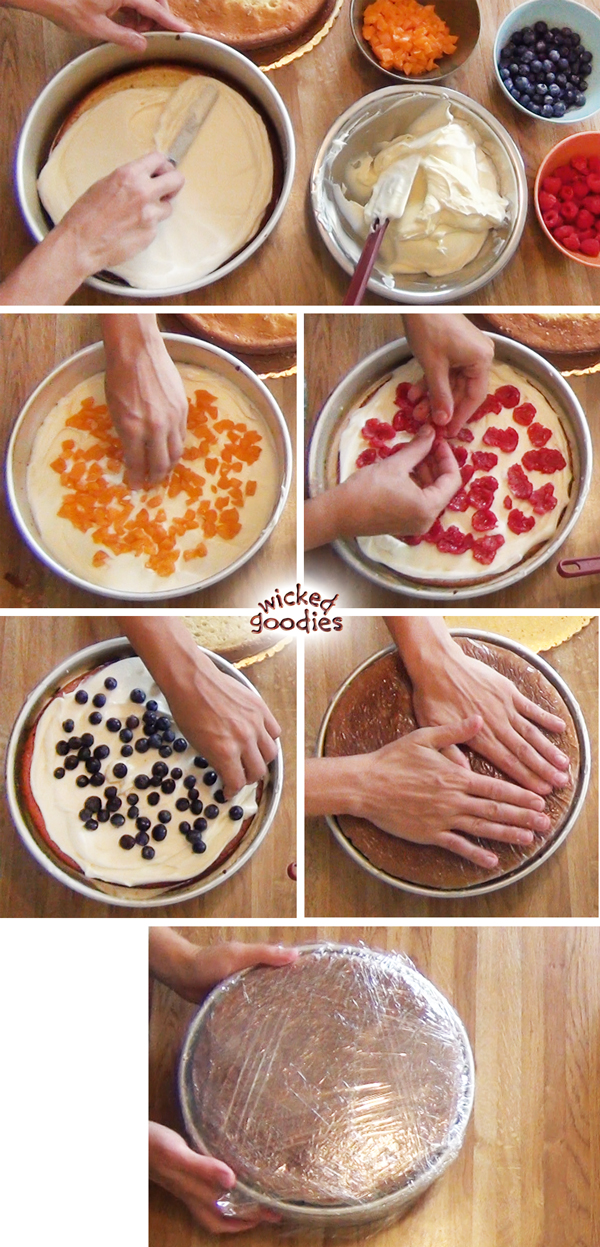
7 Pros to Freezing a Cake
#1 It’s Easier
When filling a layer cake in the pan, the pan does all the work of molding the shape. You don’t have to worry about symmetry or leveling. It’s all taken care of for you. Carving and frosting are twice as easy to do on a cake that’s made this way too.
#2 It’s More Forgiving
Even if your cake layers end up cracked or broken during the slicing stage, you can piece them together in the pan like a mosaic. The pan will hug all the parts in place as you spread the filling on top. After that, the press-wrap-freeze-thaw process (read about it here: How to Fill Layer Cakes in the Pan) will ensure all the layers including the broken one fuse together into one solid shape. In the end, nobody will ever know there was a cracked layer of cake.
#3 It’s More Stable
Because a baking pan is level, when you use it like a mold, you end up with a level cake. A level cake holds up better on display. For that reason, it’s the safer bet compared to free-form cakes, like the one below, which can be wobbly, which can lead to crookedness, which can lead to collapse.

#4 It’s More Professional
Because the cake filling gets pushed all the way to the edges of the pan, air pockets get forced out. Air pockets are one of the primary reasons why cake fillings bulge. Bulging cake fillings look unprofessional.
#5 It’s More Economical
Because this method yields solid shapes with no gaps, crooked or uneven parts that need patching, it reduces the amount of buttercream needed to crumb coat and frost. Frosting, when it’s made from real butter, is expensive. In the food industry, where costs are scrutinized, we gravitate toward the methods that are the most frugal. That’s why pastry chefs like cake filling in the pan.
#6 It’s More Efficient
This method reduces the amount of time that is needed to frost basic cylinder, square, and rectangles cakes because the filled cake starts out neat and tidy, in the exact same shape as the desired result. A cake like that will help you over the finish line.
#7 It’s More Convenient
One of the best parts about this method of filling cakes in the pan is that it allows you to begin the project in advance. For example, a wedding cake may be baked and assembled a week or more before the event. That way, you don’t have to cram all the work in at the last minute.
#8 It Lasts Longer
A properly frozen cake has a longer life. At one wholesale bakery where I worked, there was a giant walk-in sub-zero freezer dedicated entirely to 6″ and 7″ layer cakes. They were stacked in pucks, each sealed within two layers of plastic wrap. Hundreds of cakes were stored like that, waiting to be thawed, frosted and decorated. Those cakes would last for months in great condition because there were no other tastes mingling in that freezer besides cake. They were excellent quality cakes too with flavors like chocolate pecan torte and hazelnut dacquoise. You would never have guessed they’d been frozen.
That same bakery also had a giant walk-in freezer for decorated cakes, which were stored in boxes. Since the freezer environment is harsh on a finished cake, we kept this inventory to a minimum, decorating only what was needed for that week or month.
3 Cons to Freezing Cakes
#1 Contamination
Storing a cake for an extended period of time in a freezer alongside fish, raw meat, or spicy, pungent foods risks cross-contamination of flavor. A better long-term freezer environment for cakes is one that is dedicated exclusively to desserts.
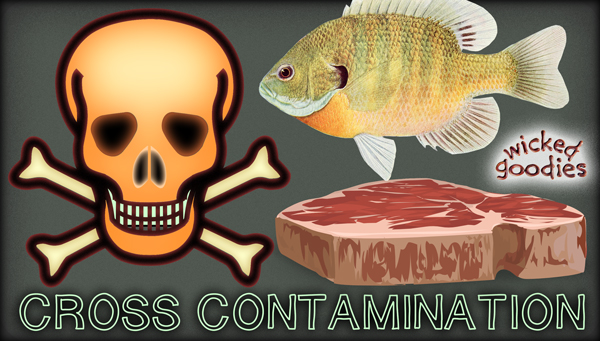
Co-mingling cakes with raw fish and meat *anywhere* is also is a food safety concern. If raw meat is present in your freezer or refrigerator, it should be well-sealed and stored under the cake, not above. Please read more on this topic here: How Not To Serve Crap.
#2 Cracking
Freezing causes cakes to expand. This is why we try to avoid freezing a cake after it’s been frosted, because the pressure of the cake expanding can crack the finish. This is most likely to happen if a frosted cake goes straight from room temperature to the freezer (for people who are tempted to try this on hot days, don’t do it) or when it goes in and out of the freezer multiple times while being decorated (also not recommended). The freezer only comes in handy during the filling stage. After that, it can lead to problems. When in doubt, use the refrigerator.
#3 Condensation
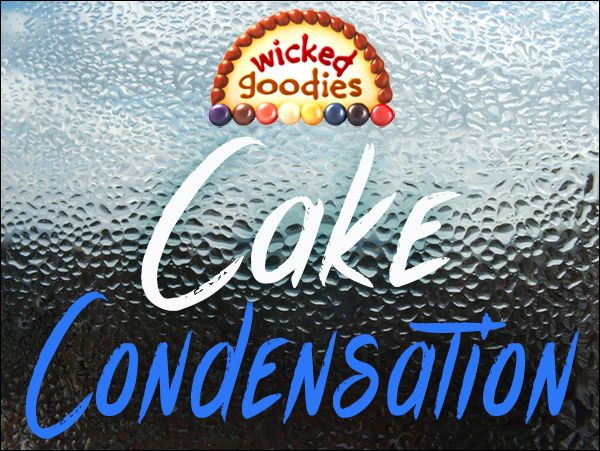
Freezing increases the potential for condensation to form on the surface of the cake. Condensation develops when warm water vapor collides with the cold surface of the cake. The change in temperature turns the vapor from a gas to a liquid, which beads on the cake’s finish, making it damp. Too much condensation can interfere with frosting and decorating.
VIDEO Tutorial: Cake Condensation Solutions
The key to minimizing condensation is a matter of temperature control. Continue reading to learn more.
Ideal Temperatures for Cake Tasks
The following graphic contains suggestions for which temperatures are the most ideal for each stage of the cake making process.

In the following section, I break down each stage of cake making from baking to delivery, in terms of how it may be optimized using temperature control.
How to Freeze Baked Cakes
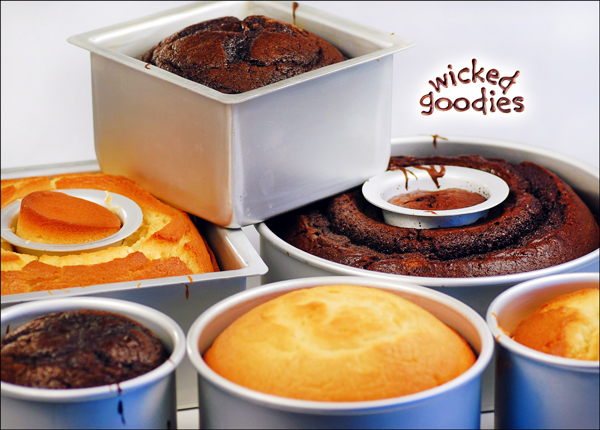
Once the cake has baked and cooled but still in its full form, it can be frozen if that suits your needs. Seal the whole cylinder (or whatever the shape may be) in at least two layers of plastic wrap. Set it on a flat surface in the freezer.
Later, when you are ready to use it, thaw it in the refrigerator. This may take anywhere from 6-12 hours depending on the size of the cake. Larger cakes will take longer to thaw all the way through. You can test the core temperature with a thermometer. You can also test it for resistance by inserting a metal skewer.
Allow a baked cake to thaw fully before attempting to slice it into layers. Too many times in the course of my career, I made the mistake of hurrying the process by slicing a cake that was still frozen in the middle. Every time, it ripped the cake to shreds. Over the years, I have learned that if I freeze a whole baked cake, the slicing process can’t be rushed. The time it takes to defrost the cake must be factored into the schedule. When it comes to defrosting, it’s better to schedule extra time than not enough.
How to Freeze Sliced Cake Layers
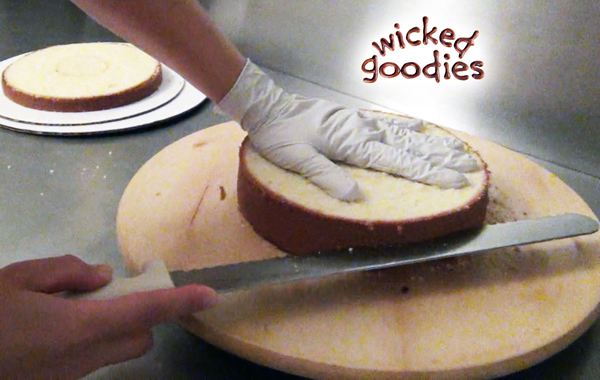
When you slice cake layers, it’s preferable to work with room temperature cake. I don’t recommend slicing a cake while it’s still hot from the oven. I also don’t recommend slicing a cake just after it has cooled. The surface tends to be a little crusty then, which makes it more challenging to cut.
In bakery kitchens, I would cover racks of cakes (fully cooled, still in their baking pans) with giant plastic bags for 6-24 hours before slicing. In a home kitchen, I’ve gotten the best results from sealing cooled cakes in plastic wrap then letting them sit at room temperature for three or more hours. During that time, the moisture inside the cake migrates to the surface, softening it.
Once the moisture content has balanced itself out, then the cake is easiest to slice.
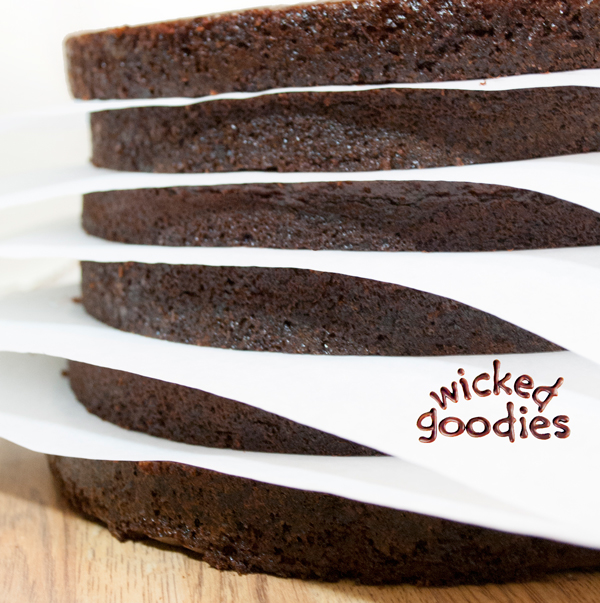
I don’t recommend freezing cake layers since it requires the use of materials but it can certainly be done. If you want or need to freeze your sliced cake layers, I recommend stacking them on a solid base (such as a cake cardboard) with a piece of parchment or wax paper in between each slice. This prevents them from fusing together. Once they are all separated, seal them within a thick bag or within several layers of plastic wrap. Don’t seal them so tightly that they get compressed.
Later, when it comes time to assemble the cake, you can work with the frozen slices if that’s more convenient for you. Or you can let them come to room temperature. Frozen slices have the benefit of being easier to maneuver because they’re durable, less prone to cracking apart. However if they are bent, curved or warped, that shape will get incorporated into the cake, which may cause the neighboring layers of filling to be too thick or too thin in some areas. That sort of imbalance has the potential to compromise the structural integrity of the cake. For that reason, I only recommend working with frozen cake layers if they are perfectly flat. If not, do take the time to defrost them.
How to Freeze Filled Layer Cakes
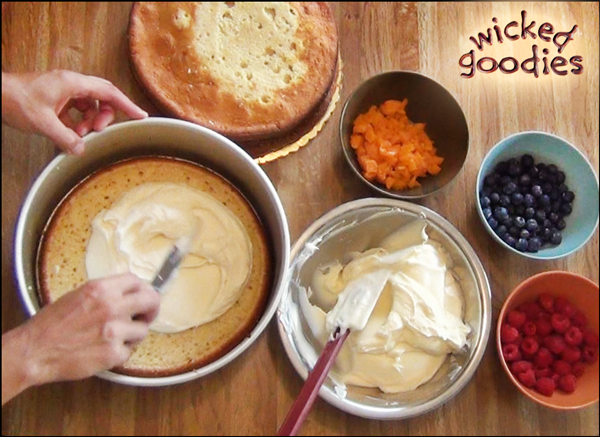
The best way to freeze filled cakes is in the pan using this professional method for assembling cake layers. The cake layers may be frozen or room temperature at this stage. There are pros and cons to each option.
It’s preferable to have fillings at room temperature because that’s when they are the most spreadable, which helps them fuse with the cake and prevent the formation of air pockets.
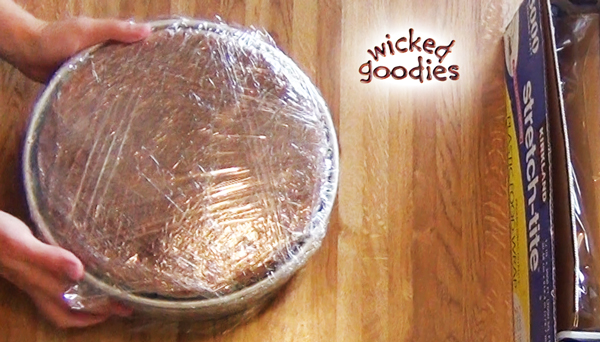
Once the cake has been assembled in the pan, it’s time to freeze it overnight or for however long you need to store it. Depending on the size of the cake and the functionality of your freezer, it will probably take 12-24 hours for the cake to freeze. Larger cake tiers take longer to freeze therefore should be allotted more time in the freezer. Large cake tiers (12″ or wider in diameter) may require as much as 48 hours to freeze. All tiers should be sealed in a double layer of plastic wrap encircling the bottom, sides and top of the pan.
How to De-Pan a Frozen Cake
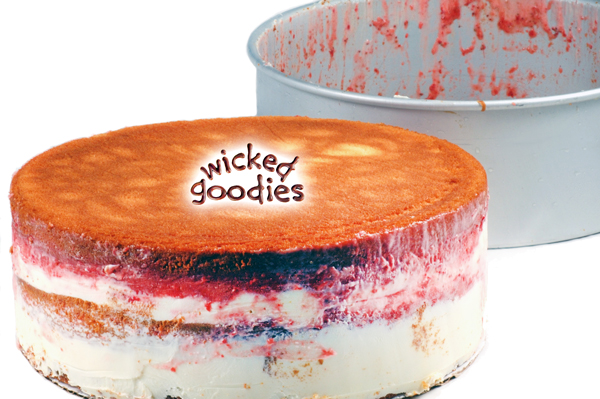
Depanning is easiest to accomplish with a frozen cake. To learn more about this step, follow this link: How to Release a Frozen Layer Cake from the Pan. After the cake has been depanned, the job of the freezer is done. I don’t recommend putting the cake back into it unless you intend to store it for a later time. If that is the case, seal it in a double layer of plastic wrap to protect the cake from the harsh freezer environment.
How to Carve a Frozen Cake
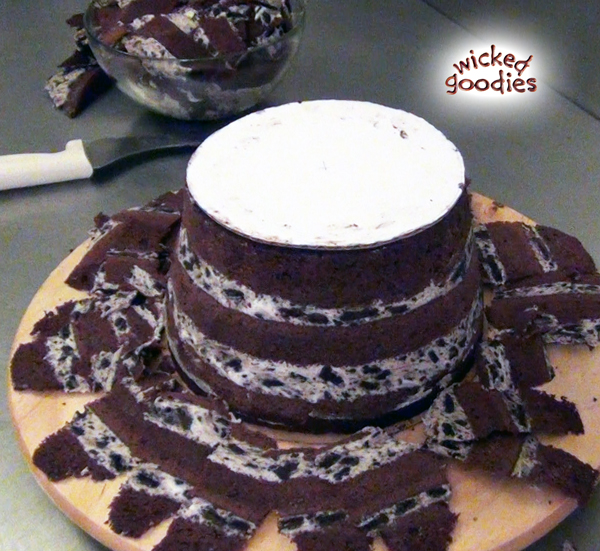
If the cake needs to be carved (for example a topsy turvy cake or a 3D fish cake), it’s easiest to do the job on a semi-frozen cake. A semi-frozen cake is still frozen but not like a rock. It surface is just soft enough to shave with a knife.
How to Crumb Coat a Frozen Cake
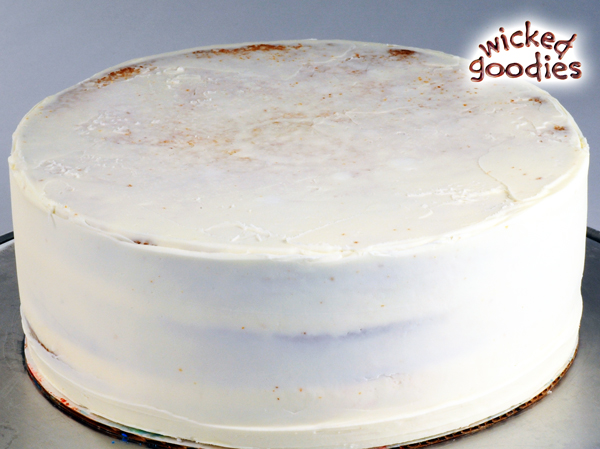
It’s easiest to crumb coat a cake, especially a large wedding cake or sculpted cake, while it’s still frozen or semi-frozen. There is less chance the cake will crumble under the pressure of the frosting tool. Best of all, the cold cake will quick-set the frosting, which helps trap all the loose bits and crumbs.
How to Frost a Cake After Freezing
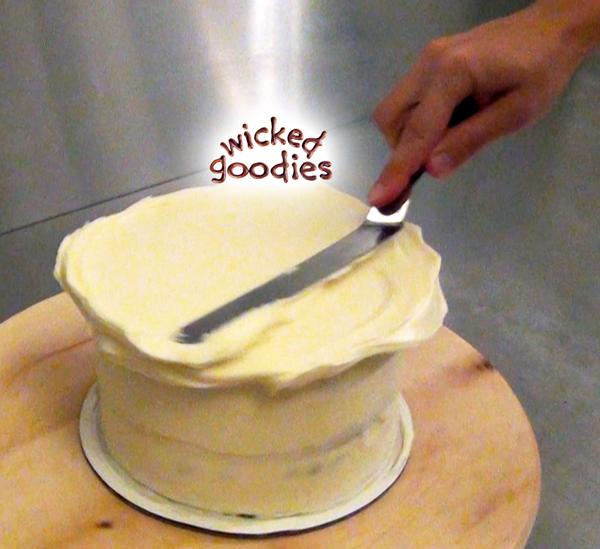
Avoid adding the final coat of frosting to a frozen cake.
If you are opting for a frosted buttercream or ganache finish then wait to add your final coat until the cake has reached refrigerator temperature. Yes, it is possible to start this step earlier, when the cake is semi-frozen, but then you are more likely to encounter condensation issues so it’s not the ideal choice. This is an extensive topic that I cover more thoroughly in the video ebook, Smooth Buttercream Cake Frosting.
Fondant & Modeling Chocolate versus The Freezer
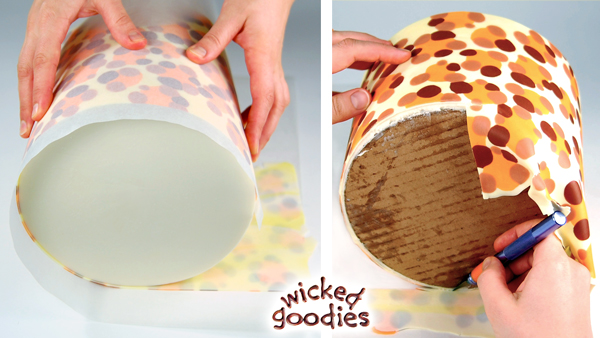
Semi-frozen cakes are easiest to wrap and cover.
If you plan to cover your cake with fondant or wrap it with modeling chocolate, note that it’s easier to accomplish when the cake is still semi-frozen. The edges and corners of the cake will stay sharp under the pressure of being covered. You can even turn the cake sideways if you need to wrap it. You don’t need to worry as much about your fingers or tools leaving divots in the surface because the cold cake will resist them.
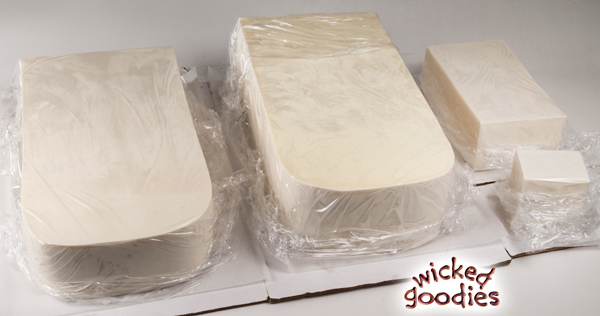
Once the cake is covered with fondant or wrapped with modeling chocolate, seal the surface under plastic wrap. Pushing too hard risks leaving an imprint of wrinkles on the finish so press gently, just enough to work the air out from underneath. When there is a tight seal, plastic wrap acts like a temperature buffer between the cake’s finish and the refrigerator environment. As the cake thaws, it will form condensation on the plastic instead of on the finish. This protects the finish from getting all wet.
Example: Below are two hamburger cake “buns” wrapped in a 50:50 blend of fondant and modeling chocolate, sealed under a tight layer of plastic wrap.
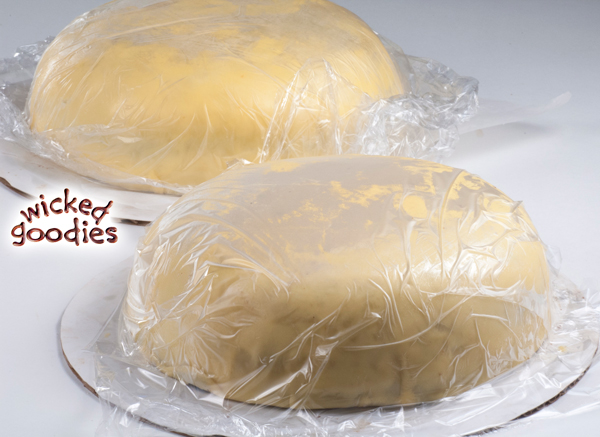
I don’t recommend putting the cake back into the freezer after the covering/wrapping stage. However if you must, it can be done. Just make sure all the exposed surfaces are well-sealed. Later, when you are ready to transfer the cake into the refrigerator, leave the plastic wrap on until you are ready to decorate. That way, the condensation forms on the plastic, not on the surface of the cake.
Cake Dowels versus The Freezer
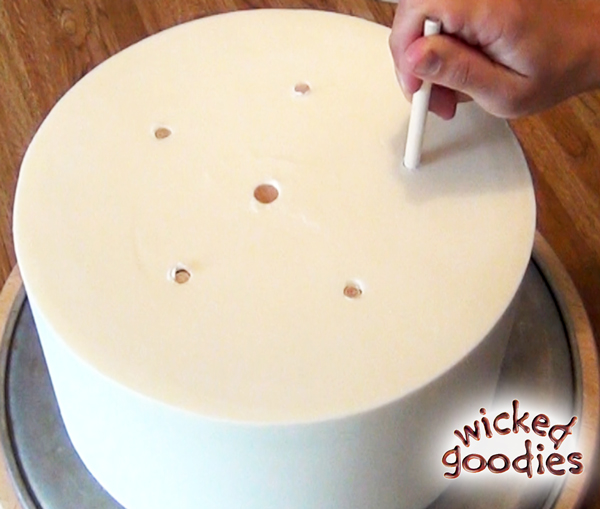
Avoid adding dowels to a frozen cake.
When the cake is semi-cool (somewhere in between refrigerator and room temperature), it’s the best time to add wood dowels or supports. It’s fair to assume the cake has reached this point after it has received its final coat of frosting or just after it’s been covered in fondant or wrapped in modeling chocolate. At that point, you’ve had it out on the countertop, exposing it to room temperature. It’s then when the cake is most soft and pliable so it will best tolerate the pressure of being penetrated by dowels. Getting this timing right is one of the keys to preventing a cracked finish. I cover more on this topic in the following tutorial: How to Use Wood Dowels in Stacked Cakes.
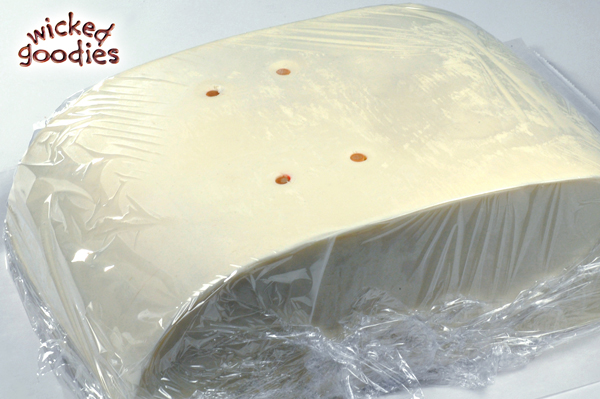
If the cake is large and complicated or the kitchen is hot or you are new to the skill of frosting, the cake probably warmed up to room temperature while you were completing the previous stages. That’s okay but now that yo’ve given it skin: frosting, fondant covering or modeling chocolate wrap and wood dowel (commission earned) bones or your choice of supports if it happens to be a stacked cake), it’s time to let it chill in the refrigerator for at least one hour before adding decorations. This step is not required but it leads to a more professional-looking finish. That’s because a firm canvas is easier to decorate. It can better tolerate the pressure of piped patterns, pressed on decorations, and the occasional bump of the hand.
While the cake gets its pre-decorating chill on, it’s a good time to clean your work station and prep your decorations.
Decorated Cakes versus The Freezer
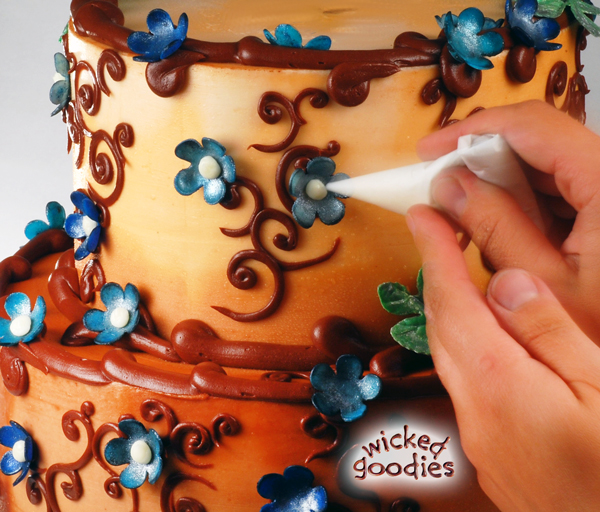
Once the decoration stage has begun, avoid using the freezer. The cold, moist air is not a friendly environment for finished work.
Throughout the decorating phase, any time you are not actively working on the cake, let it chill in the refrigerator. Chill it while you’re cutting and designing modeling chocolate flowers. Chill it when you have to answer the phone. Chill it when you break for a snack.
While you’re decorating, the cake gets exposed to room temperature. That’s fine but keep in mind that a cake can only tolerate so much warmth before it will begin to droop. A hot kitchen will speed up the drooping process.
A cool, dry air conditioned room ~ 60°F (15°C) is ideal for cake decorating.
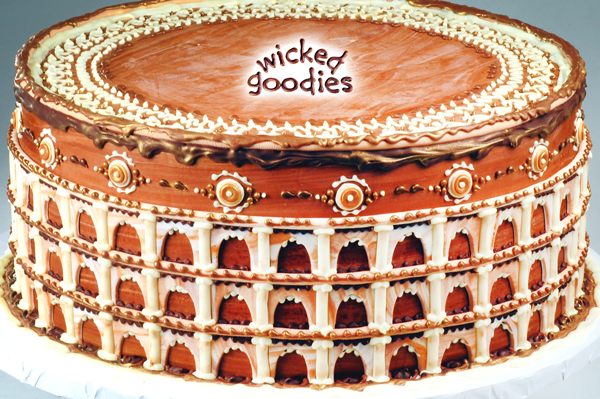
Learn more about this Roman Colosseum Cake, which was the base tier of this Ancient Monuments Wedding Cake
How to Freeze a Decorated Cake
Freezing a completed, decorated cake is not recommended but can be done within a limited scope.
Here is an example of a cake that would freeze well
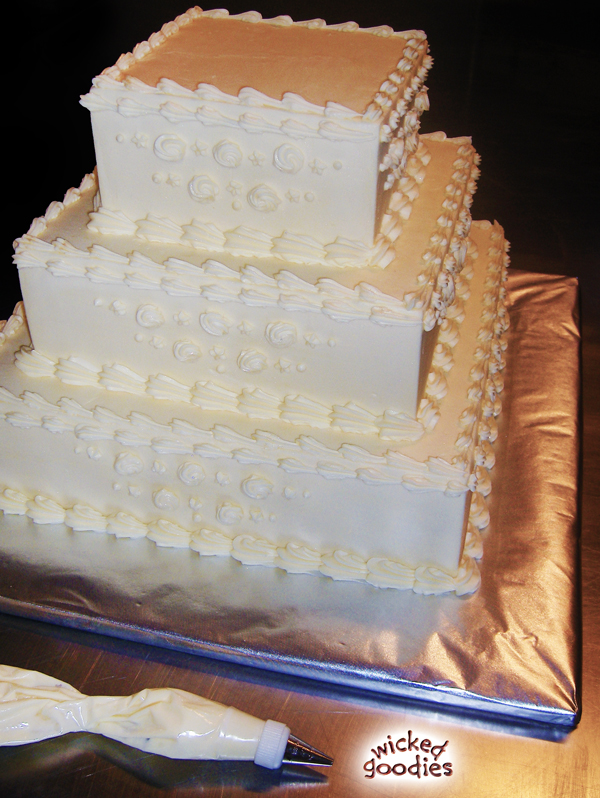
If you must, the best way to freeze a decorated cake is to put it in a box with enough head room and space that it won’t get bumped by the sides or lid of the box. Seal the box all the way around its top bottom and sides with two layers of plastic wrap. Place it somewhere in the freezer that is not directly in front of the fan.
When it comes time to defrost the cake, allow 24-48 hours for it to thaw in the refrigerator (NOT at room temperature). During that time, keep the plastic wrap sealed. Do not peel it open or off. The amount of time needed for a cake to thaw depends on its size. A 10″ diameter cake will probably take 24 hours. A 3-tier cake will probably take 48 hours.
Decorations That Don’t Freeze Well
- gumballs
- hard candies
- whole fruit garnish
- edible frosting sheets with printed images
- anything made with gumpaste
- anything made with fondant
- anything made with modeling chocolate
- dark accents on a light cake
- light accents on a dark cake
Beware of dark decorations such as red, black or blue on a white cake or vice versa. When the dark-light combination endures a freeze-thaw, there is a high probability it will streak, bleed and stain, which tarnishes the overall cake presentation. When the timing or circumstances are such that you can’t guarantee it won’t lead to one or more of those problems, you’re better off choosing a different design. In design consultations with clients, I frequently have to steer people away from this problem. If, despite my warnings, they still insist on a design that is prone to bleeding and streaking, I make them sign a disclaimer.
How to Deliver a Frozen Cake
Delivering a frozen cake is not recommended in most cases.
With few exceptions, the ideal temperature for a cake at the beginning of transport is refrigerator temperature. That way, the cake starts out cold enough to tolerate the journey but not so cold that it develops condensation. Depending on the type of cake, the style of vehicle, and the weather, there are many variables to consider. I have so much to say on this subject that I wrote a book about it.
 All my advice on dessert transport can be found in my book, Cake Delivery Made Easy,
All my advice on dessert transport can be found in my book, Cake Delivery Made Easy,
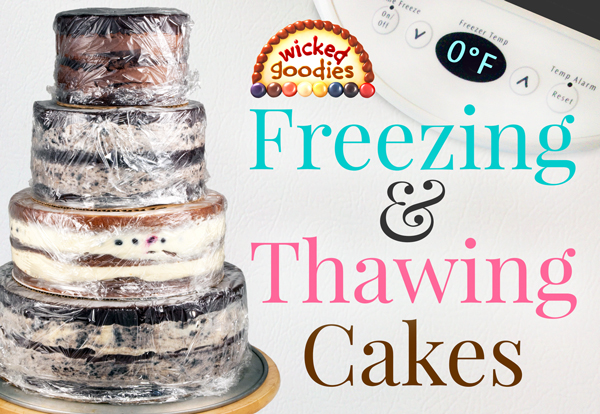




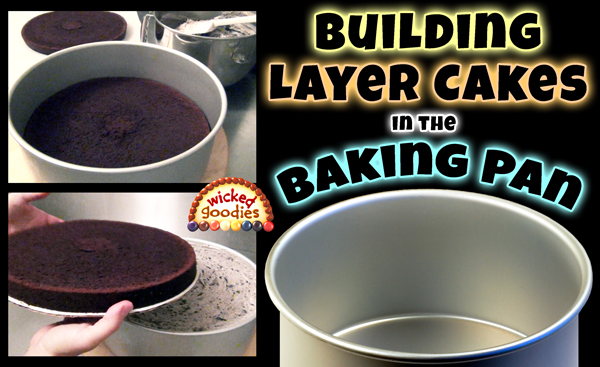



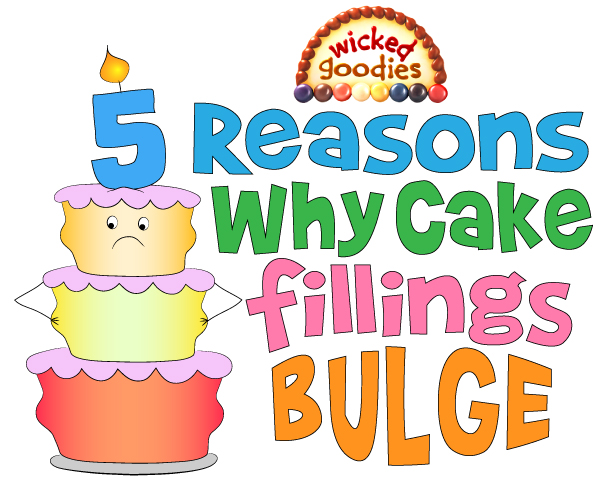
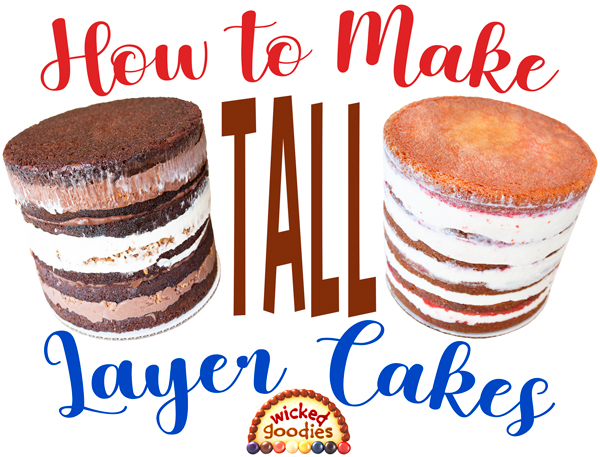
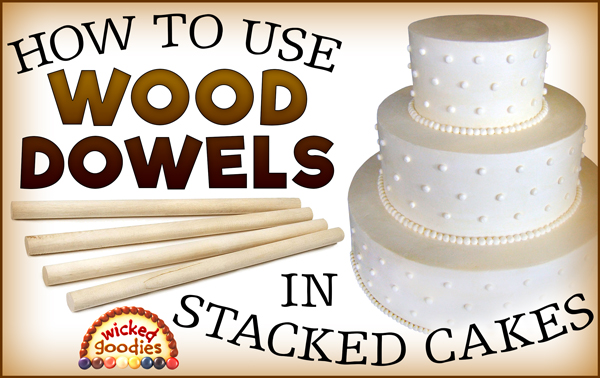

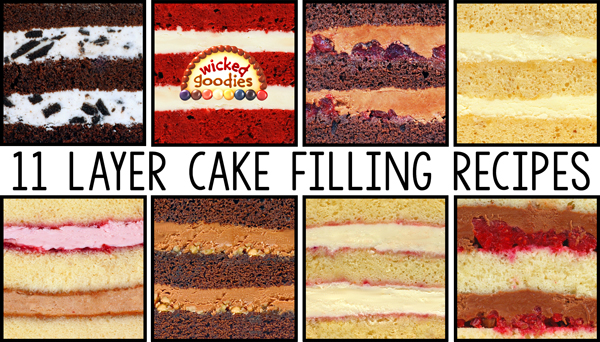
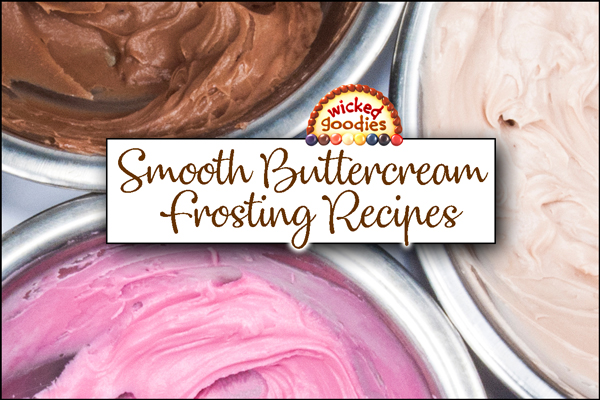
Europe, and in Ancient Russia
The tips on freezing and thawing layer cakes (unfrosted) were tremendously helpful.
HI! I am making a wedding cake this week for a Friday wedding. My problem is that Wednesday night I will not be able to work on the cake at all…I am not sure if you said, but can I crumb coat the three tiers and freeze them for 48 hours before frosting? If you can help thank you!
So, does freezing the cake change the texture of the cake? Does it make it more dense?
Love your videos.. THANK YOU! I am new to decorating cakes. How long can you leave a baked cake last at room temp. I’m running out of freezer space and want to know if I can thaw and leave it for a week. It would not be decorated just the cake.
I have had issues with my American buttercream cracking. I do not freeze after decorating; i usually leave it at room temperature. Do you have any advice?
Try refrigerating your cakes.
I do not have a deep 6 inch pan yet. I have in the past tried with a collar to build My cake and freeze. I feel like it was too tricky. I’m wondering if it would be ok to freeze 2 6 inch pucks and then put tier together?
If you happen to have two shallow six inch pans, you could try inverting one on top of the other, essentially sandwiching them together to create the effect of a deeper pan.
If not, yes, you can always freeze your cake into pucks as that will certainly assist you in the assembly process.
However the most foolproof method, which is optimal since it prevents that top layer from sliding out of alignment with the rest of the cake, is to build a collar to extend the height of your pan. There are several ways to do it. Check out this tutorial: How to Build Tall Layer Cakes as the solutions found there can also be applied to the assembly of deep cakes in shallow pans.
Thanks so much! I ended up freezing 2-6 inch 2 layer pucks in 2 inch deep pans. (Creating four layers once I removed each puck) since they were frozen it was easier than I thought it was going to be. I appreciate your advice and response! I tell ppl all the time about you! I have one of
Your books and I could watch and read all you have to teach forever! You are amazing!
(Cake was 8inch tier and 6 inch tier for my nieces first birthday, party was on Cinco de Mayo)
Samantha,
Wow you did a great job! The decorations look so much like real needlepoint! The flowers are a nice touch too. Well done! I’m glad the freezing technique worked for you and appreciate your feedback you shared about how you made it work with your equipment. Also, big thanks for telling your friends about this site.
When she is older, your niece will see photos of this cake and appreciate the time, love and affection you put into making her first birthday party so special.
Hi .. i want to ask if it possible to do the crumb coating and the frosting immediately once out of the freezer ?? Then put it into the refrigerator untill the delivery or serving time !
You will find some tips about timing here: https://www.wickedgoodies.net/wedding-cake-timing/
But I get into it much more thoroughly in this book: Smooth Buttercream Frosting
Hello,
I have 4inch pans which I will be trying your freezing method for my filled cake.
When baking the cakes, Do you recommend baking 2 2” sponges and slicing in half for the layers or bake a 4” in the deep pan using a baking heating core and then slicing for 4 layers?
I wouldn’t use a heating core on a cake that small. There is no need (heating cores are designed for larger sized tiers such as 10″ or wider). For a 4″ tier, you could bake your layers using one pan or two. I would use just one because small cakes bake so fast and it makes one less pan to clean.
So i got 12 mini mud cakes topped with chocolate ganache in a pack from the supermarket.At the back of the packet it says “previously frozen,do not refreeze”.can i really not refreeze them? And if i do, what would happen to them? Sorry sounds silly, i just want them for a later party date. Thanks!
Hi! I’m not sure if this was answered already as there are way too many comments to go through in search of my answer, but I’m making a cake with mousse layers and i wanted to make the cake the night before and then decorate it the morning of the party, and i read all the directions of freezing the cakes, but should i stack the cakes and fill it with mousse layers and THEN wrap with seran wrap and freeze?? or should i freeze just the cakes and the next day let thaw halfway in fridge, then stack/fill with mousse, crumb coat, and apply fondant….?? the mousse recipe says to let the mousse set so i’m worried if i freeze it that it will get runny or something.
Definitely freeze after assembling the layers.
I can’t guarantee this method is going to work in that short period of time. It’s doable but just not as easy to accomplish, especially if the cake is big.
There are lots of different kinds of mousses so I can’t answer to that except to say that as long as it’s a stable mousse recipe, it should be fine.
Hi I’m trying your freezing method but forgot to put parchment paper in pan will the cake still come out without sticking.
If there is no parchment on the bottom of the pan, the cake is very likely to stick. If there is no parchment on the sides, it that part should be fine.
Hi 🙂
I was wondering if you could please give me some advice on a frozen chocolate wedding cake with frosting. It was frozen two years ago and we don’t know whether it will be safe (or nice!) to eat now.
Thank-you 🙂
Eat it at your own peril.
I stored my cake and it’s still good but has been contaminated with ginger. Anything I can do to decontaminate it?
Go back in time.
Hello!
How long does it take for a cake to be semi- frozen once is pulled from the freezer?
12 – 24+ hours depending on the size of the cake
Is there a way to defrost a layer cake in two hours?
Thank you very much for your all the wonderful advice. I have a three their wedding cake to make, it needs to be delivered and set up in part on Friday as I as I have to travel a considerable distance and to finish on Saturday,I am also going to the wedding, can I iput fondant on them on Wednesday and bring them to room temperature in Thursday. I have never used your method before, I am not a professional have never made sponges for wedding cakes either. We are going to the wedding so need minimal to do on the day. Thank you again.
Yes – you can do all that. Just make sure you cover the fondant with plastic wrap.
Hi, I bought your buttercream book and it’s really the tastiest and smoothiest buttercream ever. I have a question though. After you bake you cakes and as soon as they are cool do you right away fill and stack the layers and freeze them. Or do you freeze the individual cakes unril ready to stack the cake and freeze? I make cakes just for our family enjoyment. Often when I bake I don”t get to assemble it right away. Should I freeze the cakes and then when ready stack and fill and assemble using the frozen cake and then back in the freezer until ready to decorate?
The most efficient option is to stack right away however in cases when the schedule doesn’t allow for it or when there are excess cake layers, you can freeze them.
HI,
Thank you for posting this. I have a question about cutting layers from the cake. Can i freeze the cake before i layer it? How long should i keep it in there? Here are the steps in mind:
1) Bake the cake and after 10 min take it out of the pan and let me it cool completely
2) Cover in the plastic wrap and put it in the freezer (not sure how long)
3) The the cake out and cut the layers
4) using your cake filling method, fill the cake layers and place it back in the freezer covering them in plastic and foil as you indicted.
Am i thinking right?
Just putting follow up comments: I read thru all of your comments and i got the answer i posted on sept 11th. Thank you so much for this blog. I make vegetarian cake (no eggs) and i have to say that i followed all your directions and it came out perfect. Everyone enjoyed and i was very happy with the outcome
Hi Kristen,
Panic setting in here! I’m making a wedding cake for the first time…stacked cake, 12,10,6″ layers. Moist, coconut cake recipe. It will be a semi-naked cake, as per the similar pic below. I am traveling2 hours by car to the venue, and am nervous as heck as to when to put the thin layer of frosting on, since I would like to bake and freeze the cake this week for the sept 9th wedding..can you pls advise me on timing and how to do this minimal frosting technique? Thank you so much!
You can do everything in advance. The glorious thing about this cake design is that you can touch it up very easily if you need to. Just make sure to bring some extra icing. Also make sure you have some dowels in each tier before transport so the layers don’t slip around. Without frosting, they can slide horizontally.
Bake just for family. Have no need to make it ahead. Is it necessary to freeze cake after layering? Can it just be chilled in refrigerator before frosting?
Using this method, I always recommend freezing because it’s the best way to get the whole cake out of the pan without damaging it. It’s pretty hard to mess up a frozen cake. If you are opposed to freezing, you may *try* the fridge instead although you will have to line the pan with parchment all over the sides and bottom so you have something to pull on. Alternatively, you might consider using a removable bottom pan so you can push the cake up from the bottom. However I can’t ensure a positive outcome without the help of the freezer. There are so many variables involved with different kinds of fillings and compositions and some types can be very fragile at refrigerator temp. A handful of times, I tried to remove cakes from their pans when they weren’t totally frozen and that’s when I ran into the most trouble.
Hi need an advise…I am travelling 3 months from now for a wedding. I am doing the wedding cake but i want to baked the 14,12 and 10 inch cake down followed your video and freeze them prior to the travelling time as i am decorating the cake once there.Anyway my question is can i travel with the frozen cakes in the pan in a cooling bag and freeze it overnight again before covering the cake with fondant.would love some insight on this please thank you.
Winifred, I just answered this question in the other location where you also asked it. But I’m copying the answer here too in case others have the same question.
Once you freeze a cake, it’s better to keep it frozen as opposed to putting it through the process of a freeze-thaw-freeze. A bag is risky because it doesn’t have sturdy sides to protect a cake. A box or cooler would be better. If you happen to be driving to your destination, you can keep the cakes as cold as possible in coolers and then freeze once you reach the destination. If the destination is far, you can send your cakes, undecorated, through mail, in insulated boxes with dry ice. Either way, it helps to keep the layer cakes in their pans while traveling, as per this method. The pans will prevent outside elements from leaking in and will also hold the layers together all together nice and snug.
Hi need an advise…I am travelling 5 hours next week for a wedding. I am doing the wedding cake but i have already baked the 14,12 and 10 inch cake followed your video and froze them prior to the travelling date as i am decorating the cake once there.Anyway my question is can i travel with the frozen cakes in the pan in a cooling bag or depan them and put them in a cooling bag.I would love some insight on this please thank you.
Unless you have the chance to re-freeze the cakes once you reach your destination, it will be hard to get them out. If the cakes aren’t frozen when you try to remove them from the pan, they will get stuck and likely rip/break. I recommend keeping them in the pan, if possible, while traveling.
Dry ice
Good point. Yes, dry ice is certainly an option. I have a friend who does this with cakes in the pan and it has worked for her several times. I’ve even used dry ice to send finished cakes to corporate buyers, with roughly an 80% success rate. But those were highly processed, simple factory cakes. Not the homemade kind.
When I had to travel 5 hours with a 12/10/8 tiered cake I froze 8 sixteen is bottles of water and wired them through the cardboard in the corners of boxes I got at U-Haul. To keep the frozen stacks from sliding around, I hot glued blocks of Styrofoam cut to fill the gap between cake board and sides of the boxes. I stacked the 10 and 8 inch in one box and the 12 in another and taped the boxes so no leaks and they arrived at my destination still frozen. I suggest taking the frozen bottles out before placing the boxes under refrigeration if you are transporting to the venue the next day to finish decorating. I didnt and had frozen cakes which condensation formed on as I was decorating it at the venue. I am an amateur after all.
Awesome information. Thanks for sharing. We own a very successful gourmet cupcake business. We sell mostly wholesale to restaurants and markets. Lots of our customers call in advance to order for parties. But we have a huge problem with people calling last minute for cupcakes and other desserts. The information you provided is very helpful. But I’m curious if you have any more information to provide in regard to the temperature range that you would suggest for freezing cake? I also like a little bit of guidance as to for how long you would expect the product to remain fresh
Mark,
I recommend storing the product in a sub-zero freezer, between -10F and 0 degrees F (-17 to -23C). Bulk supplies of frostings or fillings such as lemon curd should be stored in lidded containers that have a tight seal. Bulk supplies of cakes or pastries should be tightly packed to minimize the amount of air inside and also double wrapped in plastic to prevent contact with the freezer environment. Sheet trays lined with product should be fully wrapped two times including the tray itself, not just on top. The same goes for bowls of product. The plastic wrap should go all the way around. This uses more plastic but it’s the only way to achieve an airtight seal.
Note that when unwrapping plastic wrap to remove small quantities of product from your frozen inventory, the wrap will eventually lose its seal (frozen plastic wrap gets brittle over time), so it should be replaced periodically as you notice it loosening.
In terms of shelf life, if a freezer is dedicated to desserts only and the products are properly stored, they can last for several months or more in a frozen state. Smaller products with a higher surface-area-to-volume ratio, such as cupcakes, tend to lose their freshness faster than larger products like cakes, which have a lower surface-area-to-volume ratio.
Be sure to label and date your frozen inventory as well as adhere to the principals and FIFO (first-in-first-out). It’s important to refrain from unsealing a tray of desserts until the oldest tray has been completely emptied. If you have employees handling your frozen inventory, I suggest establishing a system (oldest product goes on top of the rack, or gets a special sticker for instance) then monitoring their handling of it closely. Avoiding spoilage/staleness of product is a matter of discipline and vigilance on the part of the kitchen manager.
Thanks for the reply. I realize there’s a lot of variables. Different cake recipes. Different Packaging. Different freezers. But if I’m doing everything right how long would you typically expect undecorated cupcakes to last in a freezer? We’ve always sold everything fresh. We tested a few cupcakes that were decorated then placed in the refrigerator for about a week and they were horrible. They weren’t wrapped in plastic wrap but they were in fact stored in a plastic 12 pack box. Which I realize now is wrong.
I definitely don’t recommend storing cake products like cupcakes in a refrigerator. That will in fact speed up the process of making them stale. In my experience, cupcakes are the trickiest of all cake products to freeze because of the high surface-area-to-volume ratio, the odd shape that’s not conducive to tight packing, and the liner, which depending on what it’s made of, may pull moisture out of the cake or may not hold up well through a freeze/thaw.
There is not one generic answer for how long cupcakes will last frozen. Standard practice is to perform R&D tests, storing some batches for 1, 2, 3, and 4 weeks in a freezer then performing a blind tasting, which involves a panel of people whose job is to compare frozen product with fresh. If you have success with those time periods, you can increase the test to 1, 2, 3, and 4 months.
Even if you can only freeze your cupcakes for as little as one week per batch, that still ought to cut down on your production times. Learning the answer will be worth the effort it took to perform the tests.
About cupcakes, I wrap them in two layers of plastic wrap and put them back in the trays. I find that they remain fresh for longer when frozen that way. I know it uses a lot of trays and can only really be used for someone who is not making thousands of them. I have frozen cupcakes for several weeks by this method and they a just as fresh when thawed.
Hello! The information posted has been of great help. Im currently in Sri Lanka and its quite humid during the day. I usually crumb coat my cakes and soon after keep it to chill. Once I take it out after an hour and put the final layer of icing and sometimes put it back in the fridge.
I find that after keeping the finished cake out for several hours there seems to be water collecting at the bottom! Please help.
What do you use as a crumb coat ad filling?
I use this kind of buttercream frosting for crumb coat. Other people prefer to use ganache, which also works.
Here are some examples of my preferred type of layer cake fillings.
I was asking Mihara because of her leaking problem 😉
Oh thanks for clarifying Eveline. I didn’t realize you were responding to Mihara’s comment.
Mihara, what you are experiencing is condensation. It sounds like the weather in your region is a significant factor in this being problematic for your cakes. You can learn more about how this works by watching this video: Cake Condensation.
Hi everyone! I use normal buttercream for the crumb and final cost, I usually don’t have a problem when I just chill only the crumb coat, but for straight edges I tend to put it in the freezer and that tends to mess things up!
Bingo! The freezer is the culprit. Once you start decorating, the freezer is off limits. I’m glad we figured this out and I hope this improves your results.
Hi!! Quick question. Do you recommend leaving the plastic wrap and foil on the cakes as they defrost in the fridge? Thank you!!!!
Yes to the plastic wrap to keep the cake fresh and prevent condensation from forming on its surface. No to the tin foil, which will insulate the cake thus slow the defrosting process.
Hi
So glad i came across this page as i have my first big cake order for wednesday and i was getting very stressed until i realised i could successfully freeze! My questions are:
So i am defrosting cakes layers in the fridge while still wrapped? Do i unwrap while semi-frozen or fully defrosted? Will it make any difference? I don’t want the sponge layers getting sticky?
Also i wasn’t sure if i could freeze carrot cake so i have left that to make today instead. Could i have frozen it? Its such a moist cake i was worried it would get sticky on defrosting? (Cake layers only – no filling)
Generally to stop stickiness what is your best tip? To work with the cakes while semi/frozen then put nack in the fridge or is it best to wait until fully defrosted then take out and work at room temp?
Also if i am frosting a semi frozen cake (eg vanilla sponge and frosting with whipped cream) will the cream consistency change as the cake continues to defrost where the cream touches the sponge?
Sorry for so many questions! I would really be grateful for a response. Thank you so much x
Yes to defrosting layer cake with plastic wrap on. Do not unwrap until you are ready to frost.
Yes to freezing carrot cake. That is fine.
To stop stickiness: Watch this cake condensation video
As for whipped cream, that depends somewhat on whether it’s real whipped cream or synthetic “whipped cream.” If it’s real whipped cream then it should be stabilized with egg whites or else it will weep no matter what you do. Keep in mind that whipped cream is the least stable kind of icing so you are most likely to run into problems with it.
I made a candy filled Mr. Who fez cake for my granddaughter’s birthday and the party was called off because she got sick the night before the party. I decorated it with buttercream frosting and candy and filled a center cavity with m&m’s gummy bears, skittles and milk duds. Can I freeze this cake for 2 weeks and have it look and taste fine? Thanks for your help!
Karen
Obviously I can make no guarantees about your cake. I’m not sure how all that type of candy would respond to a freeze/thaw. I would freeze/refrigerate it now until the buttercream is solid then seal it in multiple layers of plastic wrap. Put that into something else, like a box or sealed container to further protect it. Then the key is to defrost it in the fridge for 24 hours before removing the plastic wrap.
Just came across your website…..love it!! I want to learn how to decorate cakes to fill my spare time and I’m a true “newbie”. Can you explain the crumb coating ?
Thanks……
Crumb coat = thin under-layer of frosting or ganache that is designed to hold the crumbs down and seal the cake before a final coating of frosting is applied. In the case of fondant/modeling chocolate-wrapped cakes, the crumb coat acts as the sealant between the wrap and the cake. If you are familiar with painting, then the crumb coat is just like primer.
Hi there!
Love all the info! I have been freezing my cakes for years & love it but now I have someone wanting a naked cake with both a ganache & jam filling. So a double filling between each layer. Any suggestions on how to keep the jam from seeping out from between the layers when it thaws?
Spread your ganache on the top and then Use a round tip to pipe a circle around the circumference of the cake to form a barrier for the jam. It works like a dam…the ganache
Holds the jam in, preventing the leakage.
Damn, you beat me to it, Sweet Pea (pun intended) – Thanks! I second this response. A piped damn keeps the leakage from seeping.
If I am short on time, can I freeze the cakes in the pans for a few hours (about4 hours)? Will this method still work? Thank you.
It’s risky. Maybe you could do it if the cakes were very small, like 6″. But I don’t recommend it, especially if it’s your first time using this method.
Thank you for such a quick response. I will try it on my next project then. I have always been afraid to bake cakes ahead of time having the thought that freezing cakes does not yield the same flavor. Thanks to your site for giving me new knowledge.
I’m freezing a cake covered in cream cheese. After I move it to the fridge overnight and set it out at room temp the next day, do I leave it covered to come to room temp or unwrap it?
I hope you mean cream cheese frosting? I’m not sure this would work with plastic wrap. Cream cheese frosting never gets completely hard. It always remains somewhat sticky. That’s why it works better as a filling as opposed to a frosting.
I assume that you mean when you’re putting the cake out at room temp, that’s to get it ready to serve. As soon as you remove it from the fridge and put it on display, remove the plastic wrap (hopefully it doesn’t stick on the cream cheese frosting). When it’s time for dessert, the cake will be at room temperature, which is the ideal temp for eating cake.
I have a party I’m making a minion cake for Saturday night. If I completely make cake today can I freeze it (fondant coverd)? I’m worried the fondant will be ruined or cake yucky if I freeze then thaw. And when thawing cake is it in fridge or is counter better? And do I leave wrapped in plastic wrap? So sorry for so many questions!
Hi,,I’m a new home baker..so happy to get to know about ur blog as a new comer…I’m live in Dubai..these days it’s so hot in here..I made a ganache frosted fondant covered cake once.then I refrigerated it..after I cut it ,it was sticky between ganache and fondant..what can I do for that please? If I put it in room temperature , ganache or buttercream will melt or not even its inside of fondant???
Meghan,
According to the date of your comment, you asked if a cake could be completely decorated and then frozen on a Tuesday for a Saturday event. I don’t recommend freezing decorated cakes. Fondant gets gummy when it’s frozen and then thawed. You could definitely have baked and filled the cake layers then frozen at that stage. When I talk about freezing cakes, I’m not talking about whole finished cakes. I’m talking about the inside part, which you can gradually defrost in the refrigerator then decorate at the end of the week. I would keep it at refrigerator temperature unless there are no ingredients that require refrigeration.
Nisha,
Fondant is going to get sticky wherever it comes in contact with buttercream or ganache. Fondant is absorbent, so that’s natural. This is a good thing because it helps the fondant fuse to the surface of the cake. Yes, if you leave a cake at warm room temperature, even if it’s covered in fondant, the insides will soften. Fondant does not act as an insulator in terms of temperature.
Hi,
I don’t have clear a few steps ?..PLEASE help me!
You say to assemble the cake in the pan (to put the filling in the various layers of cake) and then freeze in the freezer.
The after day, put out of the freezer and pan, then wrap in two rounds of film/plastic wrap and refrigerate but how long before crumb coating the cake with butter cream or ganache?
Until I see that the cake is semi-frozen?
If so, how long it takes more or less?
When crumb coating with ganache or butter cream, I don’t put the plastic wrap, right?
In your photo I see the cakes in the refrigerator covered with ganache without plastic wrap.
Then you say that if the cake has to be covered with fondant, this should be done when it is semi-frozen … so, the passage of coating with ganache or butter cream and the passage of covering with fondant are done at the same time? (one after the other)
Or between the coating and the covering I must put the cake in the refrigerator for a while?
If so, for how long, since the cake should however be semi-frozen to be covered with fondant, correct?
I mean that in this way does not pass too long time between one step and other and in meantime the cake is likely completely defrost?
I have a doubt also about the plastic wrap on fondant…
You say of cover with plastic wrap even after covering the cake with fondant because so, putting it in the refrigerator, the fondant covered with plastic wrap doesn’t create condensation, right? But if I put the film on the cake covered with fondant, this don’t damage a little bit?
Not there is the risk that the film leaves on the fondant some signs / scratches chipping away at the nice smooth coverage?
Last question is: if later, as the last step, I have to add various decorations (2D and 3D) on the fondant that covering the cake (decorations always in fondant), I can’t continue to cover with plastic wrap because it would damage the decorations, but between one decoration and the other, I have to continue put the cake in the refrigerator, especially if they are decorations that take time … there is danger that it creates condensation and everything collapses without the plastic wrap?
Sorry if I made all of these questions but I will try your method of freezing and I’m afraid of making mistakes all!
I hope to receive your answer… is very important For me!
Thanks For your time
I cannot tell you how long your cakes will take to defrost or if they will thaw completely as you work on them. That depends entirely on the size and composition of the cakes, the temperature of your freezer, and how fast you work. A good rule of thumb is to leave 24 hours for the defrosting stage. Hopefully you’ve checked out building layer cakes in the pan and this video supplement on layer cake building in the pan. I encourage you to explore some more of the content on this site including the questions and answers in the comment sections.
As for the question about damaging the fondant with the plastic wrap, as long as you don’t press down on it too hard, it shouldn’t leave a mark. You don’t want to rub it or wrap it too tight as that can cause discernible creases on the fondant. However as long as you are working with a cold cake, the fondant will tighten up as soon as it goes on the cake, which will make it more durable. Keep in mind that when you first remove the plastic wrap, you might see some discoloration in spots where the plastic touched the surface versus where air bubbles got trapped. You might be able to see traces of the texture of the plastic wrap in the beginning – but that should all even out as the cake comes to room temperature.
You will need to use your best judgement on when/if you continue to add plastic wrap to a cake once the decorations are on it. Certain kinds of decorations won’t tolerate the plastic wrap, like luster dust, chocolate piping, buttercream piping, painting, delicate 3D flowers, etc. As a rule, I always wrap the cake unless there is a chance that might harm a decoration. Sometimes I wrap it loosely when 3D objects are involved. In most cases, I wait till the last minute to add those kinds of decorations so I can keep the cake wrapped airtight. This will minimize the potential for a decoration to wilt.
You really cannot avoid the issue of condensation when it comes to temperature changes but you can work to minimize its effects. You will learn a lot from trial and error. In the meantime, I am working on a video that addresses more of these concerns as you are not the first to have so many questions. I hope this helps.
thanks for reply … I’m looking forward that the new video is ready!
Thanks for your help
When you say semi-frozen what temperatures exactly do you mean? I have tried the freezing method but I didnt’t know i had to wrap it in plastic wrap once covered in fondant to stop condensation (my cake fell apart because of this but the freezer did make it unbeleivably moist !!!!!!) Thank you soooooooooo much for this article you saved my life!!!!
I mean anywhere between frozen and refrigerator temperature. If it’s totally frozen, you have to battle major condensation issues. When it’s half frozen, not so much. Cakes thaw from the outside in, and condensation reacts to the surface of a cake, not the internal temperature, so before the cake is completely thawed to fridge temp, it’s okay to start in on the frosting. At least, that’s my rule.
Thank you for the reply hun will post my results
Hi,
Your site is really helpful.
I’m making a 3D elephant cake for my husband’s birthday on sunday. I’ve made a few fondant cakes myself, but it’s the first time i’m using the freezing method, because I have to carve the cake.
I made all layers of the cake and have frozen it for 2 days now. I’m planning to carve it on semi-freeze. I’m unclear on what to do afterwards.
From what I understand on your blog, I was thinking of crumb coating while semi-frozen, then bring to refrigerator-cool temperature and buttercream frost carved cake. Then wrap in cling wrap and refrigerate until sunday morning. Thaw to room temperature with wrap still on, then fondant decorate it.
Will this method cause any condensation on fondant after decorating?
Thank you so much.:)
Pavi
Pavi,
You’ve got all the steps right except the part that involves fondant. When the cake is refrigerator cool, wrap it in fondant. Then, cover with plastic wrap. Remove the plastic wrap once the cake is ready to go on display.
When going from cool to room temperature, you will always experience at least a little bit of condensation. How much will vary depending on your/weather climate. If you follow the steps outlined above, you should minimize the risk.
I would love to see the results of your husband’s elephant cake! I hope you will come back to share a photo when it’s done.
Thank you for the quick reply.
I will wrap in fondant too then. And is it okay to keep the buttercream frosted cake wrapped in refrigerator until sunday morning? Or should i freeze again? I’m frosting tonight.
I will definitely share a picture afterwards.
Again, thanks heaps. 🙂
Pavi,
I assume your cake is already finished but the answer was yes, that is okay! No, you don’t have to freeze it a second time.
Hi,
Sorry I haven’t been able to reply sooner. The cake came out great! But I think the freezing caused condensation, which made the elephant drop a little while in the refrigerator after carving. I haven’t used any structure, which might also be reason why is didn’t stand on it’s own.
But overall it came out great!
Thanks for your help.
Oh wow – that is fantastic! To address your concerns about settling, the condensation wouldn’t cause whole parts of the cake to drop. Condensation is strictly a surface issue that can cause things like decorations to go limp from getting wet (any kind of decoration that requires dryness like fondant, modeling chocolate, gumpaste, are all averse to moisture). Freezing can however deceive us around issues of structural integrity, meaning a cake can sit on its side and withstand more weight from above when it’s frozen and refrigerated but we have to keep in mind how gravity and weight distribution will affect the cake once it’s soft. From trial and error, we tend to learn what a cake can withstand at room temperature so you will go into the next project knowing more.
Looking at this photo, I’m not sure where the cake drooped because it looks good all around. It looks to me like it was intended to look just as it is. Are you referring to the head? I ask not because something looks wrong with it but because I can see that the snout is much smaller than the whole head and is basically supporting all the weight from above. Once thawed, especially with fondant which tends to be heavy, that bulk of that head was sure to weigh down on the snout. I’ve seen a lot of animal heads pop off of cakes – dog cakes especially. The neck here looks intact though so that’s a win if you ask me. But yes – some structural supports in the snout would have made sense. I would have made that snout from rice treats with a thick dowel running down the middle in order to support the weight of the head above.
You live and learn with these things. All in all, you did an excellent job Pavi and should be patting yourself on the back for a job well done! Thanks for sharing a photo. I had been wondering how your project went and am pleased to see your excellent results. Cheers! – Kristen
Hi Kristen,
Thank you!
I posted a picture below while I was carving. It was standing straight up, since there were 4 layers of cake. The leg behind the head was struggling to keep attached to the cake and to stand. I think it was a little thinner than the other legs which was one reason for not being able to stand.
After i crumb-coated and left in the fridge, it drooped little by little. So I had to stack a fondant covered potato, (which i removed before cutting the cake 😀 ) underneath the head so that it might not fall.
But I didn’t keep the cake in the fridge after I fondant covered it, because I didn’t want it breaking apart if I tried to wrap it in cling wrap, and it didn’t condense.
I wasn’t planning on making the snout out of cake too, but did so because there was space on the cake. However, just afterwards I was looking through the internet, and discovered that rice treats and structures are used when making cakes like these.
But I was proud that I was able to make the cake without either. 🙂
Thank you for your method, the cake was very moist when after freezing which I never knew. And i’m glad I found your blog, now I have someone to take cake advice from, which I did all on my own up until now.
Thanks again.
Pavi
Pavi – Fondant covered potato – BRILLIANT! I can’t see where the leg is drooping but that’s a good sign. It means only you as the artist were aware of the problem. In those cases, the trick is to pretend it was all done on purpose and make no apologies, as your clients/friends will be none the wiser. I’m glad I could help and look forward to seeing some more of your work in the future.
Thanks. Yeah, it went well after all.
For sure. Thanks again!
Hi again Kristen,
I’m making a chocolate ganache covered layer cake for this weekend. I was wondering if it works well to layer the cake and kind of crumb-coat with ganache, just as your buttercream frosting method, and freeze the cake. I’m making the cake for a friend’s birthday and will have to defrost it and ganache the final outer layer on sunday, the day of the party.
I was thinking of freezing the separate cakes, but figured there might be condensation between layers afterwards. Will it be a problem freezing with ganache layers? Or should i use BC frosting as usual?
And the outer layer will be chocolate ganache only with lace decorations and a few gumpaste flowers. So should i keep the cake in the refrigerator until the cake is needed since the outside is ganache only? And if so, should it be wrapped in cling wrap or is it okay to keep it in the fridge without wrapping?
I know I got so many questions!
Thanks so much. 🙂
Pavi
PAVI,
This is Kristen. I’m answering within your comment because this thread got so long, there is no longer the option to reply. I hope I’m responding to you in time. Yes, you may freeze the cake in that state although the ganache crumb coat might crack and yes, you might develop condensation between the layers. In my opinion, a crumb coat takes so little time that it makes more sense to do it at the last minute along with the finish coat to avoid these issues. But if you must, you can freeze at that stage. After crumb coating it, chill the cake until the crumb coat is hard then wrap it in plastic wrap to protect the cake and then keep the plastic wrap on the cake through the defrosting stage until it’s time to add the final coat. After you add the final coat, don’t use plastic wrap anymore but do keep the cake in the fridge until it is ready to go on display. Since ganache contains cream, it must remain refrigerated.
Good luck!
im overwhelmed with all your helpful tips on cake. you are one in a million ! thanks so much dear
You’re welcome 🙂 Thanks for your nice comment.
Thanks for all this advice. I was sure freezing cakes was not good but now I’m planning to try this method of freezing in the pan then, after de-panning and semi-thawing in the fridge, covering in ganache and then fondant. I understand that once the ganache has firmed up a bit, I must wrap in cling film & chill in the fridge until completely firm before covering with fondant. You say that even after the cake is covered in fondant, it should also be wrapped in film if kept in the fridge to prevent condensation messing up the fondant. I’d like to decorate one of the tiers with edible silver leaf. Is it safe to wrap & chill this tier or should it be done as late as possible & then left out of the fridge? How long would it stay fresh out of the fridge?
Yes you’ve got that right in terms of wrapping the fondant. I’m not sure about the silver leaf though. My guess is that the silver leaf will stick fast to the fondant and not come off on the plastic but you will need to experiment first to be absolutely sure.
Hi, I am making a 12″, 10″, 8″ and 6″ chocolate/baileys buttercream, red velvet/cream cheese frosting, lemon/lemon buttercream and coffee/coffee frosting wedding cake. I have all cakes made and layered in tins and frozen. Just wondering about time frame to finish crumb coating, applying fondant, etc. I have to transport cakes quite a distance on a Thursday afternoon for wedding on Friday. When should I remove cakes from freezer, when should I crumb coat and when fondant has been applied, should I insert dowels, wrap in clingfilm and leave wrapped until assembling at venue? Will cake still be moist and taste good even if I remove from freezer on the Tuesday evening? Thank you for your advice!! Jacqui.
Jacqueline, You’ve probably already delivered your cakes by now but for future reference: Cake Timing Schedule
Hi
I baked 3 cakes and froze on Tuesday for a party on Saturday. I need to sculpt them then will be crumb coating and covering in fondant for decoration. Will the cake be OK to take out tonight to sculpt and crumb coat, refrigerate then fondant and decorate tomorrow night/ Saturday morning? I’m worried about the cake going stale!
Thanks
Helen
Yes – they should be fine. As long as you keep them sealed with plastic wrap until they are frosted, they should not go stale. You definitely want to start them defrosting now.
That’s great. Thanks so much for such a swift response!
I froze some 4″ molded cakes in tupperware containers without first wrapping them in plastic film or aluminum foil as I was worried it would destroy the detailing on the cakes. Will they still be fresh after one month in the freezer?
If there is air inside the container, the surface of the cake is still likely to develop condensation, which will turn to ice in the freezer, which will turn to water when the cake defrosts. For that reason, I recommend sealing the surface of the cake in plastic wrap. If the cake is already frozen when you do this, it shouldn’t damage the detailing. Then I would recommend removing the plastic wrap after the cake has thawed to refrigerator temperature but before it comes to room temperature. I don’t recommend freezing decorated cakes since decorations don’t fare as well with the extreme temperature change. However it can be done. Success is largely dependent on the colors used and durability of the decorations.
Cont’d.. I want to make sure I understand this method. Bake cake, let it cool at room temp, put back in pan, add filling and layers. Wrap individual layers in pans, freeze it 24hrs,defrost in fridge, take out semi frozen then crumb coat, put back in fridge, take back out frost cake, put back in fridge, take back out to apply final layer of frosting, then it can be delivered??????
That sounds about right, yes. I would let the cake rest overnight before delivery so it’s nice and hard during transport. That will help it maintain its stability.
Hello!
First I want to thank you for all the great information you shared. It has helped me understand where I can improve my time schedule(it can get crazy if you are not efficient)
In the past I would start off in the wee hours of the morning and work on my cakes throughout the day. I really want to start using this freezing method so I doing lose my mind.. literally
si congelo una torta el dia miercole y la congelo luego la saco el vienes y decorarla con fondan la dejo fuera de la nevera para el sabado por la tarde se conserva fresca .
A very well evening
I just want to find out I’m doing 2 traditional wedding cake what I would like to know is that I want to start baking sponge cake on Monday then once I’m done should I let the sponge to be completely cool or should I wrap the sponge after 15 min of coming out of the oven? Then can I still cover the cake butter cream and freeze for 2 or 3 day? Lastly can you please send me the person vanilla sponge cake.
Yes, let the sponge completely cool before wrapping it. Yes, you can cover the cake with buttercream and freeze it however I suggest sealing it once again before freezing it. You can harden the frosting before sealing by putting the cake in the refrigerator for an hour or in the freezer for 5-10 minutes.
HI I am making a wedding cake for March 11 2016 and have a week off from 12th February. I wanted to know if I would be able to make the 4 tiers ganache both the inside & cover in ganache and then freeze if possible. I cannot find anywhere that says if this can be done. If it can please can you tell me how to freeze it and how to defrost it to lastly cover it in fondant and decorate on the week of the wedding? I know it isnt related but the bride wants different randomly sized pearls/beads on the cake and I was wondering if you had any ideas how to apply them as there will be a line or two around the bottom of the cake and some other pearls/beads randomly scattered going up the cake. Similar to the picture I have attached. I hope you can help me, thanks x
Hi.
please help.
I have baked a birthday cake. Its got a image on made of ricepaper.
Can i freeze the cake for 5 days ?
Isebel,
Yes you can freeze the cake for 5 days but you are better off waiting to apply that image until after the cake has already thawed. When it comes to edible images, waiting until the last possible minute will minimize the potential for damage.
Thank you so much.
Catz,
Yes, you can freeze ganache. It has a tendency to crack though when freezed in a shell, so I would wait to frost it until the cake is done freezing using the method described herein.
Here is an article about How to Plan a Cake that you might find helpful. I loaded this up onto the website early just for you!
As for the pearls, you can affix them onto the fondant using tweezers and melted white chocolate as glue. Do this before the cake tiers are assembled.
Elevate your turntable so that it’s at eye level when you do this. Leave yourself extra time for this step as it is tedious doing one after the other and always takes more time than you think.
Good luck!
Thank you so much for your reply but I do have a problem because the wedding is on a Friday and I have to deliver it on the Thursday night. I work all day Monday – Wednesday which is why I was wondering if I could make the four tiers and ganache them and then cover with cling film, foil and then put in a box in the freezer for just over two weeks. Then I would get them out on the Tuesday/Wednesday cover them in fondant and then put the beads on all day Thursday so they would be ready for delivery Thursday evening. I would really like to know if you can advise if this is ok as I have never made a wedding cake before!!! Thanks so much for the tip about the white chocolate. Just one last question: Do you think I should make the beads from modelling fondant or just buy them? Thanks also for putting the plan up earlier as I will be doing most of the prep in my week off when I plan to also make and ganache the cakes if you think it will be ok. Thank you so much this site is great!
Catz,
It doesn’t sound like you have a much of a choice on the timing so if you must ganache in advance, I recommend keeping some extra on hand in case the coating cracks, so you can seal it.
It’s totally up to you if you want to buy the beads or not. It’s just a matter of time and preference. You can try making them well in advance if see if you like how they come out.
Do the beads one tier at a time so that you can keep the rest of the tiers refrigerated. Ideally, you want those cakes to be cold before delivery. This will help all the elements remain stable in transport. Good luck!
Hi! I’m kind of in a time crunch with this one but was wondering if I could freeze a cake that has already been carved. I am doing a small vw bug cake and I wanted to do a trial run first but if it looks okay I was going to freeze it and just use it instead of making another one. Any help would be much appreciated!
Yes, absolutely! It will make the cake easier to handle this way. Just be sure to seal it tightly in several layers of plastic wrap.
Thank you so much for the quick response! Knowing that will definitely save me time. I was just afraid that if I carved first then froze it might dry it out because it doesn’t have that outer layer on it but good to know!
Hi, You site is amazing, thank you so much.
I have always powered through my cakes, the wedding cakes I have done have been 3 day marathons. I have never trusted freezing cakes because taste and freshness are always priority. You can have a beautiful cake, but if its doesnt taste amazing then why make it. The more I do, the more I come to know…I cant do that realistically and stay sane! I have read alot and talked to many and understand freezing is PERFECTLY FINE. So my process begins. Your site is wonderful! Thank you so much!!
So my biggest question right now is, can I bake, cool, wrap, and freeze individual cakes… then fill, assemble, crumb coat, then refridgerate to thaw for the final frosting and decorating
Cheri,
I hope I understand you correctly, that your question is can you first freeze just the cake sponge? If so, the answer is yes – definitely. You can freeze the whole thing like a big puck, but I’m not crazy about doing that because then you have to let it thaw completely before slicing and freezing a second time as an assembled layer cake. However this is the best choice if it’s simply an extra hunk of cake and it might be a while, like months before you use it.
When I freeze the sponge for an upcoming project, I prefer to slice it first then layer the slices between parchment (or wax) paper. That way, when it’s time to build the cake, you don’t have to wait for those layers to thaw. They will be nice and firm, which will make them even easier to handle. I stack them on top of a cardboard base, also lined with parchment, and seal them very securely in multiple layers of plastic wrap.
I once worked in a bakery where we did this all the time. We prepared giant sleeves of extra pre-sliced cake layers with parchment pan liners in between, and then whenever we were building cakes, we’d dip into the supply. It was very efficient and the cake layers stayed fresh, because we were constantly cycling through them. It sure works!
I’m glad this will save you from those 3 day marathons with barely any sleep! (oh do I ever know about that…) As long as you keep everything well sealed throughout the freeze/thaw process, no one will ever be able to tell the difference in the cake. Yet it will make all the difference in terms of your quality of life that week.
You are so amazing! I am impressed with such a quick and thorough response. Thank you! And glad to hear I was not alone in the crazy marathons.
So thank you for the added info of slicing (leveling) first. I will bake, cool, slice, wrap and freeze. I am excited about the convience and time management and looking forward to the results.
Thanks again!!
Hi Kristen,
I just completed the below cake. Can I freeze it even with the edible picture?
I placed cake in cake box. Put plastic wrap 3 times and placed another plastic bag.
I’m afraid that picture will bleed.
Should I redo it again?
Your advice would be appreciated.
Sent from my iPad
So I froze the cake for 5 days. Wrapped it well. Yesterday placed cake in fridge and checked it today. It’s beautiful. Edible paper did not discolour or bleed… It’s fine. No condensation….
Lucia,
Yesss – I’m so glad this worked! Especially since I was not online to answer this question before you served the cake – sorry about that. You did a lovely job! Frozen themed for a frozen cake – how fitting.
For future reference, my experience with edible images has been mixed. It seems to depend on the quality of the image – type of frosting paper used, ink, etc. At one bakery where we used a lot of edible images that we printed ourselves, we had a lot of problems with bleeding and bubbling perhaps because of the materials used. So we would fix them onto chocolate plaques. Rather than placing them directly on the cake, where they could absorb moisture from the back, we anchored them into melted chocolate then let that dry and trimmed around the edges to make them into a solid form, which helped protect them from condensation all around.
We also waited to place them onto the cake until the last possible minute, which would have been my advice to you, so I’m extra glad that this worked out anyway, freezing and all. Thanks for coming back to share your results!
I wanted to ask if i’ll be freezing my cake today Dec. 23 and ill be decorating it on Dec 26 is it possible that the cake will not spoil on Dec 28 which is the event date?
Yes, this would be entirely possible. Sorry for not getting back to you in time for this particular project. I hope it went well!
HELLO. SO I CRUMB COATED A CAKE THAT I WILL BE COVERING WITH FONDANT AND I ACCIDENTLY DIDNT KEEP TRACK OF TIME AND ITS BEEN HOURS…SO I TOOK MY CRUMB COATED CAKE OUT OF THE FREEZER AND NOW ITS REALLY MOIST!!!!!…… WHAT DO I DO?…. I NEED TO TURN IN AT 4 PM TODAY. PLEASE HELP!!!!
You can dab off the moisture with a paper towel. When you add the finish coat, immediately get the whole surface of the crumb coat covered before you start perfecting the frosting. That will prevent condensation from getting trapped between the two layers.
I am making a wedding cake for my BIL. His wedding is next Saturday (19th). I’m wanting to try your filling method this time (it looks awesome) and am trying to figure out my timeline. I’m not sure how long it will take to become semi-frozen though so I’m kind of floundering here.
Saturday (tomorrow): bake, fill, and freeze. Although I do have only 1 pan for my 6″ and am doing a double barrel cake so I’ll need to do one on Sunday.
Wednesday: depan, seal and put in fridge.
Wed/Thurs (?): when semi-frozen crumb coat – put back in fridge to continue to de-frost.
Friday: final coat of BC (no fondant on the cake), put in dowels, and chill in fridge
Saturday: transport to location, assemble, place decorations (pinecones, sugared cranberries, and greenery) and display.
Is taking it out on Wednesday too early? How long does it take to get to semi-frozen? I am making a 6″, 9″, 12″ italian creme cake with a cream cheese buttercream crusting frosting. It’s not as tall as your cakes, but with the double barrel style (or extended height) it’ll become taller. I’m also worried about having enough fridge space to keep it chilled with it that tall. I’ve always assembled and crumb coated the cakes, freeze, then took them out early morning – set on counter, later that afternoon I did the final coat/decorations, assembly, and done. But then, I’m not a professional (at all) and only do cakes for my family. Once every year or two. And typically the weddings were in the summer and outside in the hot weather.
Oh, and last question — after my crumb coat I put the saran wrap back on, right? Well, let it chill in the fridge for 15 minutes or so until it’s crusted, then put it back on? Or just leave it off?
Your timing schedule, including taking it out on Wednesday sounds good. The 12″ tier will take a while to thaw, so that makes sense. I don’t recommend thawing at room temperature though as that will increase the potential for condensation.
As for the crumb coat, you don’t have to cover that with the plastic. If it does get wet from condensation, you can always just dab it with a paper towel.
I recommend doing your best to consolidate the food in your fridge so there’s room for the cakes. There is so much more control when you work with cold cakes versus room temperature cakes in terms of frosting. That is, when working with butter-based buttercreams and fillings. If your frostings and fillings are shortening-based, then you can get away with working at room temperature.
Good luck, Rochelle!
Thank you so so much!
So I can bake my cake, crumb coat and cover it Fondant, then wrap and store in air tight container then freeze? It won’t crack?
Then slowly bring it to room temp before completing decorating?
If I was making my own wedding cake and the wedding was on a Saturday, should I remove it from freezer Tuesday or wed, finished decorating Thursday or fri and refrigerate ?
I don’t recommend frosting, covering with fondant and then freezing. The freezing stage that is described here is really meant more as a filling and de-panning trick.
I have done what you describe before, but only when the party was rescheduled because of an emergency. The problem is that fondant gets gummy and runny when you freeze it. When you do freeze it, it’s critically important to seal the surface of the fondant completely beforehand and then let it thaw fully to refrigerator temperature before removing the plastic. This can work although it is not ideal…
Your timing sounds okay. If it’s a small cake, you can go with the tighter window. Large tiers are the ones that would need more time to thaw.
Good luck with your wedding cake!
Hi! I received a large orderly of cakes and i do have a dedicated freezer for the sponges but I don’t have enough refrigerator space to thaw them all. Can I leave the sponges on the counter to thaw, while unwrapped? They are not filled yet.
Also for my buttercream, should I open the container while it thaws or just leave the lid on? I live in a country where it gets quite hot.
Thank you!
Just the sponge part – sure! As for the buttercream, keep that covered at all times until you are ready to use it. Put it in the coolest, least sunny part of your house/bakery.
Thank you so much!
How long will a cake stay fresh after freezing, defrosting ang icing it? Thanks
I wouldn’t push it past 3 days, but that’s just my preference.
My question is: I trimmed my cakes to get a tapered look. I did this in the frozen state, then crumb coated, let rest and cool. Then I decorated it with another layer of frosting and then the fondant. Pic # finished cake. Pic #2 cake as it sat at event. Cake started settling and getting wrinkles. I have never had this happen before. Why did this happen? Guess your only getting 1 pic not sure if it’s 1 or 2. But main thing is cake was shrinking and fondant was wrinkling
Nice cake! It still looks good. I’m guessing that the main problem was gravity. It’s like when you wear knee socks how eventually they settle around the ankles because legs are tapered while gravity is constantly exerting its force in a downward direction. The combination of those two things means the sock or in this case the fondant wants to slide down. Tapered cakes are not as receptive to being wrapped with fondant for this reason.
A couple of other things that can also exacerbate this type of problem are:
1. Putting the fondant on thick. The heavier the fondant, the more likely it is so sag.
2. Adding a thick crumb coat. The layer underneath should be thin. If the crumb coat is too thick, the fondant is more likely to slide on it. You really want the fondant clinging to the cake, not to a bunch of frosting because cake is so much stronger than frosting, especially at room temperature. Only add enough crumb coat to bind.
3. There is a chance that this is related to the fillings and interior structure of the cake. If the fillings were too soft, that would also create bulging and settling as the cake comes to room temperature.
My last suggestion is that if you drape fondant over a tapered cake instead of wrapping it, it will not sag as much.
Thank you I appreciate you replying.
I wanted to thank you for the information about frosting frozen (filled)cakes before they thaw to refrigerator temperature. I have been doing that and the frosting becomes wet and mushy and almost impossible to apply decorations on. I was so baffled but now thanks to you, I know why this happens and will change my routine.
Glad to help!
How long can you leave a decorated cake in the refrigerator and it still be moist?
You can leave a decorated cake in the refrigerator for 4-5 days and the inside should be fine, but the outside might get gummy or run with colors due to condensation.
Hello,
I am going to bake and fill my vanilla cake in a day. Freeze it for a couple days. Thaw (still wrapped) in fridge til fridge temp. Crumb coat. Frigde. Frost and decorate. Are my steps right? Newbie here. 🙂 I appreciate your site very very much..
Yes, that sounds right. See steps A – J above.
Hello! I am making my own wedding cake for 75 guests this Saturday. I’m thinking a three tiered cake but not sure what pan sizes I should use. I’ve never made a cake for this amount of people. Please help….
Semper Fidelis *Michelle*
Michelle,
Use the cake servings charts. They are all calibrated to 4″ tall cake sizes.
Hi 🙂
I did a fondant cake.. I did not decorate it yet.. I wrapped it up in plastic wrap and foil. Then put it a box that I also wrapped in saran.. It’s now in the freezer..
What’s the best way to thaw it ?
Should I put it in the fridge all wrapped up? Or right on the counter?
Thank you !!
The best way to thaw a cake is to slack it off in the refrigerator. That means allowing it to defrost slowly until it reaches refrigerator temperature. So yes, put it in the fridge all wrapped up.
Thank you so much ! I appreciate 🙂
Hi Kristin,
I wanted to try assembling a cake in a 4″ deep pan and freeze it, however, I was afraid to do so since my cake shrunk considerably after it came out of the oven. Do you have any idea why this happens? Also, can I still assemble the cake even if it is slightly smaller than the pan.
Thanks.-
Palmira,
Yes, that kind of shrinkage happens sometimes. When you have that kind of extra space, you can pipe frosting into it as a way to get the frosting stage started.
Great! Tx a lot!!!!
Can I freeze a crumb coated cake, and then start decorating it partially thawed? Thank you
I don’t recommend that you start decorating the cake until it has reached refrigerator temperature or else it will develop condensation, which interferes with decorations and causes colors to run.
Hi, i am not sure if chocolate ganache is same as buttercream as most of the comments in the article r using buttercream. I would like to make a cake with chocolate ganache friosting & crump coat then follow with fondant. I would like to know which ways r better n less time consuming:
1. After baking the cake, let is cold for few hours then wrap it 2 layers then keep in the freezer. After few days/weeks, i take it out layering the cake when semi-frozen? Then add chocolate ganache then crumb coat then follow with fondant?
2. Or, i can cake the cake, let it cold down then layering the cake, add chocolate ganache using your ‘cake filling method’ then wrap, and keep in the freezer.
– can i use hair dryer instead of fire-torch gun to remove the cake from tin as i am just a beginner home baker?
– after removing the cake which already hv the layering ganache, i need to chill n keep in the fridge for 6-8 hours? Before i adding the chocolate ganache crumb coat? Will my cake expand? Or anything i need to take nte.
– lastly add fondant n deco, n jus keep it in room tempt?
If I’m reading you correctly, it sounds like #2 is the best option. You may use ganache frosting/filling interchangeably with buttercream frosting/filling. It performs quite similarly. Like buttercream, cakes with ganache should stay in the refrigerator.
You can find more info about the filling process here: http://www.wickedgoodies.net/2013/09/how-to-fill-layer-cakes-video/
Yes you can use a hair dryer.
Thsnk u so much for your reply. Another 2 questions:
1: is that ok to bake cake using the 4″ depth cake pan with home oven? As i afraid using 3″ dept cake pan is not deep enough to try your cake filling method, and yet I do not want to purchase too many pans. So, wonder the fat daddio’s 3″ & 4″ depth pan will work the same using the same recipe.
2. I m trying a chocolate cake that is quite crumbly, so i dun think can slice/layering the cake after baking it. Is it better to put in freezer then slice later or leave it in the fridge (will keeping in the fridge make the cake stale)? After slicing, follow with the cake filling method, n return the cake back to freezer?
Thank u in advance for ur patience n assistance in answering my questions.
1. The 4″ depth pans fit awkwardly into a standard oven because there is not enough room to use both racks, so that’s why I recommend the 3″ for home bakers. With that said, you can still use 4″ pans, but there will only be room for one rack’s worth of pans.
2. You can freeze the whole cake before slicing but then you have to be patient and wait for the whole thing to thaw before cutting into it. If the middle is still frozen, it will mess up your layers. An alternative approach is to first slice then freeze the layers with a piece of parchment paper between each one.
When a cake first cools down, it usually has a crispy bread-like crust, which makes slicing more difficult. A trick to making cake slicing easier is to first let the cake rest at room temperature, wrapped in plastic for 24 hours so that the moisture re-distributes itself evenly throughout the sponge. Just like bread, when you seal the cake in plastic, the crust gets soft.
I don’t recommend using the refrigerator to store the cake sponge as indeed that will make it stale.
Thank u so much!! With your experiences and comments, u made my journey to start baking a cake so much easier. I wont ended up wasting ingredients, time and effort in making a stale & unpresentabke cake. You r such a wonderful person to share your knowledge, really glad i found your page. Thanks heaps for all your help.
Hi Kristin,
I just wanna drop you a note to thank you once again for the great tips especially ‘freezing cake method’, ‘how to fill a cake & depanned it” and of cos how to keep the cake moist, and the tip of waiting the cake cold n wrapping it with cling wrap for 12-24 hours then only slice it….etc!!
I never thougt i could go this far! My first time trial an error cake (Clash of clans cake) everything went so smooth except making the figurine and learning to crumb-coat a cake. Then i used ur method & managed to bake my 2nd cake -Disney Frozen cake! This is the main reason that made me wanna start baking a cake – my gal’s 4yo bday n no budget to buy her a fondant cake.. But with all ur tips, i can make her dream came true. Everything using a hand whisk cos no budget again.. Everyday i so stress n afraid the cake will collapse, fondant sweat, cake turned out not wat i expected n disappoint her… But, the result is rewarding! Thanks heaps from me.
My first cake
My 2nd trial an error cake for my daughter – lauren’s 4yo bday. Disney frozen themed
My 2nd cake stay moist (bake and freeze 1 week in advance).
My first cake is not so solid as i think the choc-nutella icing could be too think and too soft to hold the cake together.
I used chocolate ganache for my 2nd cake and it is more solid in holding its shape. I also did keep my 4″ tier in the fridge after putting on fondant, wrapped, and took it out but keep the cling wrapped on till the cake reach the room tempt then i assembled/stacked it. No problem! No sweating! YES, ur tips all fool proof! We can keep fondant cake in the fridge!
Mimee!
Wow! Success! The Frozen themed cake looks professionally done! The Clash of the Clans figurine is perfect! You did an incredible job. I’m so glad these tricks worked for you. Thank you for sharing photos of your excellent work. I see a lot more cakes in your future 🙂
– Kristen
Thank you for replying. I greatly appreciate it. I love your tutorials. Thank you for sharing knowledge with us
Hi good day, after covering my cakes with fondant can I leave it to come to room temperature, then decorate it?
This only works if the cake fillings and frostings are room temperature stable with no eggs or creams.
For instance if the cake is jam-filled with shortening-based frosting, you can do it. In that case, I recommend first defrosting the cake to refrigerator temperature then from fridge temp to room temp with the plastic wrap on the cake the whole time.
I need to surprise my bf with a bday cake but hard to get away from him can I make the cake, bake it then freeze it for a week? Will it still be fresh?
Yes. The answers are in this article.
Hi, my questions is. If I use plastic wrap to cover a cake with either fondant, or modeling chocolate. Will it not leave marks on the surface of the cake from the plastic wrap?
It shows marks only at first, when the cake is cold. It’s faint and you can only see it on dark colors from certain angles. After about 10-15 minutes of the cake being at room temperature, they fade.
One thing that can cause marks is bunching the plastic around the cake. It’s better to lay it flat and clean on the surface. It’s important not to press the plastic too hard onto modeling chocolate as that can transfer the texture of creases. Fondant is a bit more durable but I do all my modeling chocolate wrapped cakes this way too.
I’m delivering a large 3 tier wedding cake in a couple days, the condensation is worrying me and my refrigerator isn’t big enough to refrigerate….any suggestions? Thanks!
Theresa, I hope your wedding cake went well. Here is a 4 tier topsy turvy wedding cake (170 servings) plus a 2 tier birthday cake (45 servings), all fitting easily inside of a refrigerator that is not even the standard full sized. It’s a 3/4 size. There was still plenty more room for drinks and snacks on the door and underneath in the crisper. So unless you were making an enormous wedding cake or are dealing with a micro-fridge, I don’t understand what you mean when you say your fridge isn’t big enough.
Oh, I should have said my fridge was too full to hold the cakes. But, I made it work and made sure there were no onions in my fridge:-). Thanks! One day I’ll get a dedicated cake fridge…already have a freezer just for cakes.
I’m glad to hear that you made it work. Smart thinking on the no onions. One consolation prize that comes out of this process is that you end up with a clean refrigerator in the end. The day when you get a dedicated cake fridge, you are golden!
Thanks for the quick response! I’d be honored if you’d like my new page on FB! It’s called “Baking Rock Stars and Rookies Welcomed“. I think your input would be invaluable whenever you’d like to comment. Feel free to share any tips, tricks or post about any of your upcoming classes or new books..etc. It’s only about a week old but I’m trying to write everyone I follow or have learned from and I love your book! My page is called “Teresa’s Oatmeal Overboard” if you’d like to see my work, its just a hobby as my career is in the medical field. But, Thanks for reading!!
Can you freeze any filling with it? Strawberry, ganach, raspberry, lemon,etc?
Amanda,
The only things I would avoid are angel food cakes and cakes with Bavarian cream filling, neither of which tolerate freezing. Cakes with whole large fresh strawberries inside are better off not frozen as well since strawberries shrink after freezing. Smaller bits of strawberry work fine however. Those are the only exceptions that I have encountered over the years.
Gracias por tus consejos, creo que aprendí mucho,pregunto…con cuantas hora de anticipación puedo sacarlo de la nevera para ser entregado y cúando lo parta este a temperatura ambiente.gracias,esperando tu pronta repuesta.
De nada. Es mucho más seguro para mantener la torta en el refrigerador hasta que sea hora para la entrega .
Just wanted to say thank you! Your website is amazing. I’m just a humble, self taught, trial and error type home baker. I really only make cake for family and friends as a hobby, but I enjoy it so much. It is so satisfying to have a beautiful finished product! Anyhow, I have to say, the information I have found on your website has, by far, been the most helpful as well as the easiest to understand. I just wanted to let you know that it is all VERY MUCH appreciated!
Marie,
Thank you for taking the time to connect with me! I love hearing from people like you and am glad to learn that this material has been useful to you. 🙂 – Kristen
I agreed with Marie, ur tips r really helpful, straight to the point and humble. Appreciate so much for sharing all these tips and taking ur time to answering questions. It is sometimes very hard for a beginner like me to find all the answers for these basic techniques, without throwing/wasting cakes, and ingredients.. U r jus amazing!
Thank u once again
When do i remove The plastic wrap, after I have covered the cake with fondant, how long do I have to wait to remove the wrap and start finishing decorating?
Keep the plastic wrap on until you are ready to start decorating. Don’t take it off until you are all set up and ready.
I didn’t get it, how to fill the cakes in the pans, then when do you slice them, before filling them? Thanks
Yes. You bake the cake, take it out of the pan, and slice it. Then you fill the layers by building the cake back into the pan. You can read more about it here: How to fill layer cakes
THANK YOU SO MUCH!
SO WITH THIS METHOD, YOU DONT NEED TO PUT A BUTTERCREAM BORDER AROUND THE LAYER TO THEN FILL IT?
The buttercream border technique is still necessary if you are using a thin, unstable cake filling. I prefer to use more stable cake fillings so that I don’t have to bother with a dam. However adding that border, when necessary, is a bit easier to do when you build layer cakes in the pan.
Do you have a MOST preferred stable cake filling? A “go-to”?
HI, First off thank you so much for the very valuable information. It is very kind of you to share. My question is Can you freeze a completely decorated cake either in fondant or modeling chocolate if a party gets postponed or something happens that the cake is needed at a different time? And if so should you still wrap a fully decorated cake carefully with plastic wrap or can you place decorated cake in a box to size and then wrap the outer box several time with plastic wrap? Take out of freezer and place in frig for 24 hrs and then on counter until it comes to room temp. Will the decorations hold up ? and what if the decorations are figures? Thank you ,
Hi Wendy,
Technically, yes, in a pinch, you can freeze then thaw a completely decorated cake using both of the methods that you mentioned. However if there are dark colors on a light background, some bleeding may occur. The freezer is not the ideal environment for fondant or modeling chocolate decorations; all 3D decorative elements will be at risk for damage so if it is possible to pull off the figurines before freezing, I would recommend it.
Thank u so much for your reply 🙂
After I put fondant on my cake, you said to wrap it in plastic wrap. Can I then put it in the refrigerator? The first time using fondant I put my cake in refrigerator it turned into mush.???
Yes – Covering a finished cake in plastic wrap is the solution when using the fridge (which is recommended) as it prevents condensation from forming on the surface of a cake. That condensation is what makes fondant sticky or as you describe, mushy. Cutting off contact between the cake and the fridge air solves this problem.
What if you cover the cake in fondant n wrap in plastic wrap and Refrigerate… If it’s humid outside, what would happen to the cake when you finally have to transport it / display it? Won’t it be overwhelmed by condensation? Or would it be safe if you keep the plastic wrap on till such time that you have to display it?
I suggest always keeping the plastic wrap on until it’s time to display the cake. This will help preserve the freshness of the cake as well as keep its appearance clean. It will also protect the finish from developing condensation. If it’s humid outside, the cake will get sweaty so the longer you can delay direct contact between the cake and the air, the better.
Hi!
Can you freeze a cake with whipped cream frosting over it?
Yes. As long as it’s stabilized with something like gelatin, egg white, or powdered egg white.
I need to remove my filled and frozen cakes from the pans so I can reuse my pans for filling and freezing more cakes. Can I depan an rewrap and put back in the freezer for a couple off months? I love the filling in the pan method and am going to try it.
You can definitely freeze cakes not in the pan. A couple of months like that is longer than I would suggest for a home freezer but you can increase your chances of success by wrapping the cake several times with plastic wrap then sealing it within a heavy duty container.
What is your experience with what happens after the cake is delivered and sits at room temperature for a few hours. Do you have any problems with sagging, filling compressing out the side of the cakes or air bubbles appearing in your fondant as the cake warms? I’ve had all of those things happen when I’ve tried to use the freezing and decorating while slightly frozen method. I’m just a hobby baker and only bake for family, but if I had more confidence in the final outcome I might try baking for someone else.
If you have issues with sagging and filling squishing out, that problem is not related to a cake being frozen. It happens because the filling is too soft. Some fillings, especially soft cream cheese fillings, are not strong enough to withstand being on display for long periods of time. The squish-out will happen no matter what if that is the case and then the cake will start to sag as well.
As for air bubbles under the fondant, that problem is also un-related to freezing and thawing. It results from leaving air gaps under the frosting (around the edges of filled layers) or between the frosting and fondant. The latter instance can be corrected by poking a hole with a pin and squeezing the air out.
It sounds like you may have attributed some problems to the freeze/thaw method when in fact they were not related. You can still have confidence in this method but perhaps need to reconsider your choice of filling and/or filling method.
How do you keep the cardboard circle from getting soaked when the defrost? I tried freezing cake layers and the circle was a mess by the time they were defrosted. I think the supports would break thru making the cake unstable. I really want to be able to freeze. Help please! 🙂
Thanks Cindy
For larger wedding cakes, I recommend using a double-strength corrugate. Alternatively you can tape or hot glue two regular cake boards together to make a stronger board. For bigger cake projects, especially topsy turvy cakes, I pull white electrical tape around the edges of the cake boards to strengthen them up so that moisture can’t creep in the openings. There is also this type of greaseproof cake cardboard out there that has a laminated coating on it.
very nice i like your website i am from lib am merci
De rien!
Why should wrap a Cake in plastic after covering with fondant or modelling chocolate, I didn’t get that?
If you seal the fondant or modeling chocolate under plastic wrap, that will prevent condensation from forming on the surface of the cake (see above, the passage about how condensation forms).
Can a cake that has been frozen and thawed out be re frozen . Same question about buttercream . Can it be frozen , thawed out for use and refrozen ? One time only ?
Yes but I don’t recommend thawing and re-freezing a cake repeatedly. Buttercream, as long as it sealed in an airtight container, is more tolerant of a second or third freeze/thaw.
Hi, excellent post!! Do you share your cakes recipes? Or there is a place where I can buy them? Thanks in advance
Sorry, I haven’t released any cake recipes yet.
Can you freeze pumpkin cakes also? Is there a kind of cake you wouldn’t recommend freezing or ingredient?
Yes! The only type of cakes that I wouldn’t recommend freezing are cakes with Bavarian filling. Be advised that WHOLE frozen strawberries, blueberries, and raspberries within the filling will change consistency (get soft and ooze juices) as fruits tend to do when frozen. However as long as whole fruit is layered next to the cake’s sponge, that should absorb all extra juices, which is a good thing as it will make the sponge taste even better.
Can you freeze a cake after moistened with flavor syrup?
Yes you most certainly can freeze a cake after moistening it with flavor syrup.
Hi I’m a home baker s o I don’t have many pans, is it still ok in to freeze the cakes not in a tin? Thanks for the great explanation x
I wrap my cakes in cling film and them foil to give more protection , do this to all my cakes and they are well received. Said to be lovely and moist with a nice firm texture x
Hi Kelly,
Yes it is definitely okay to freeze cakes not in a tin! Two tight layers of plastic wrap is all I use.